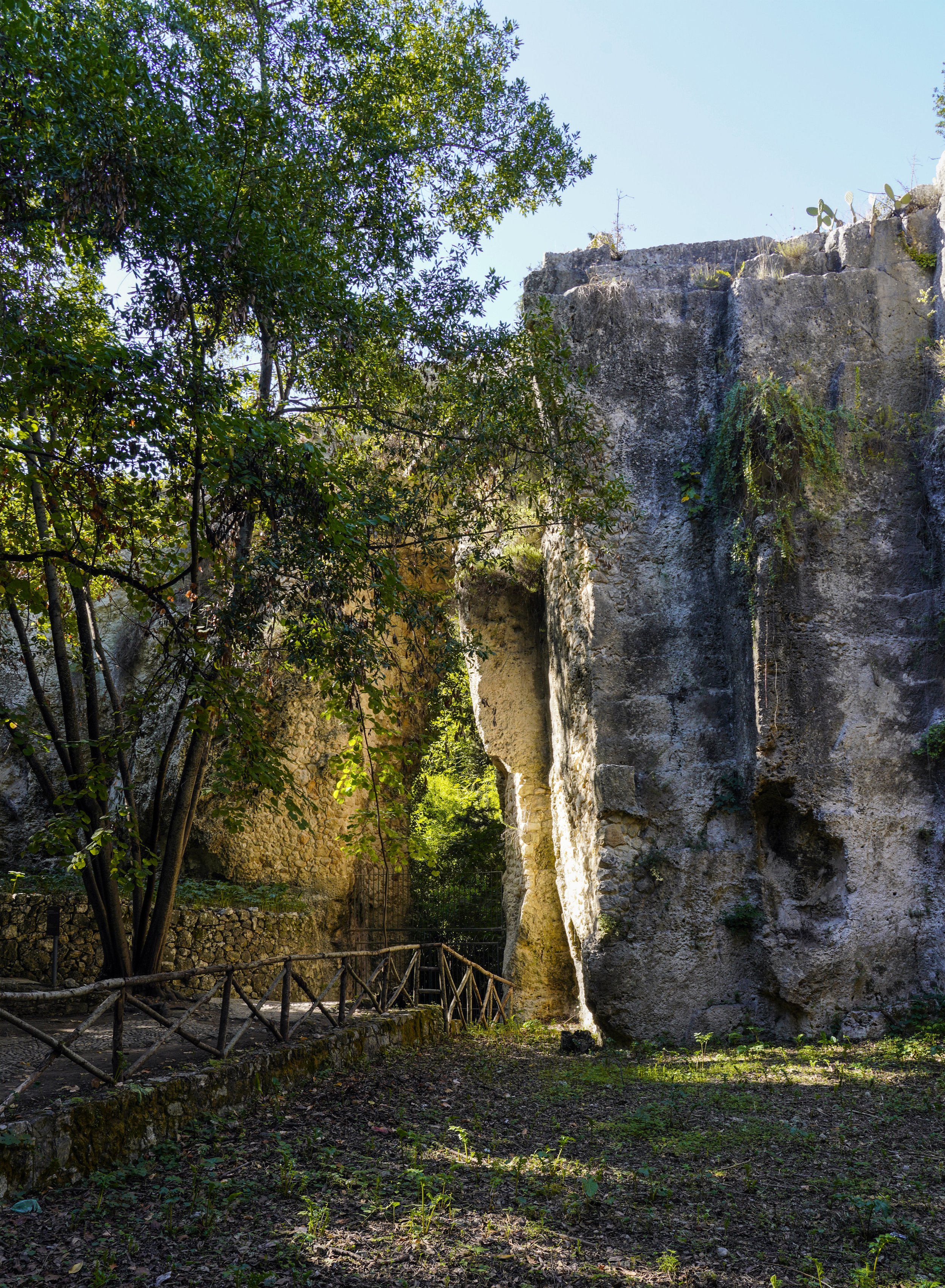
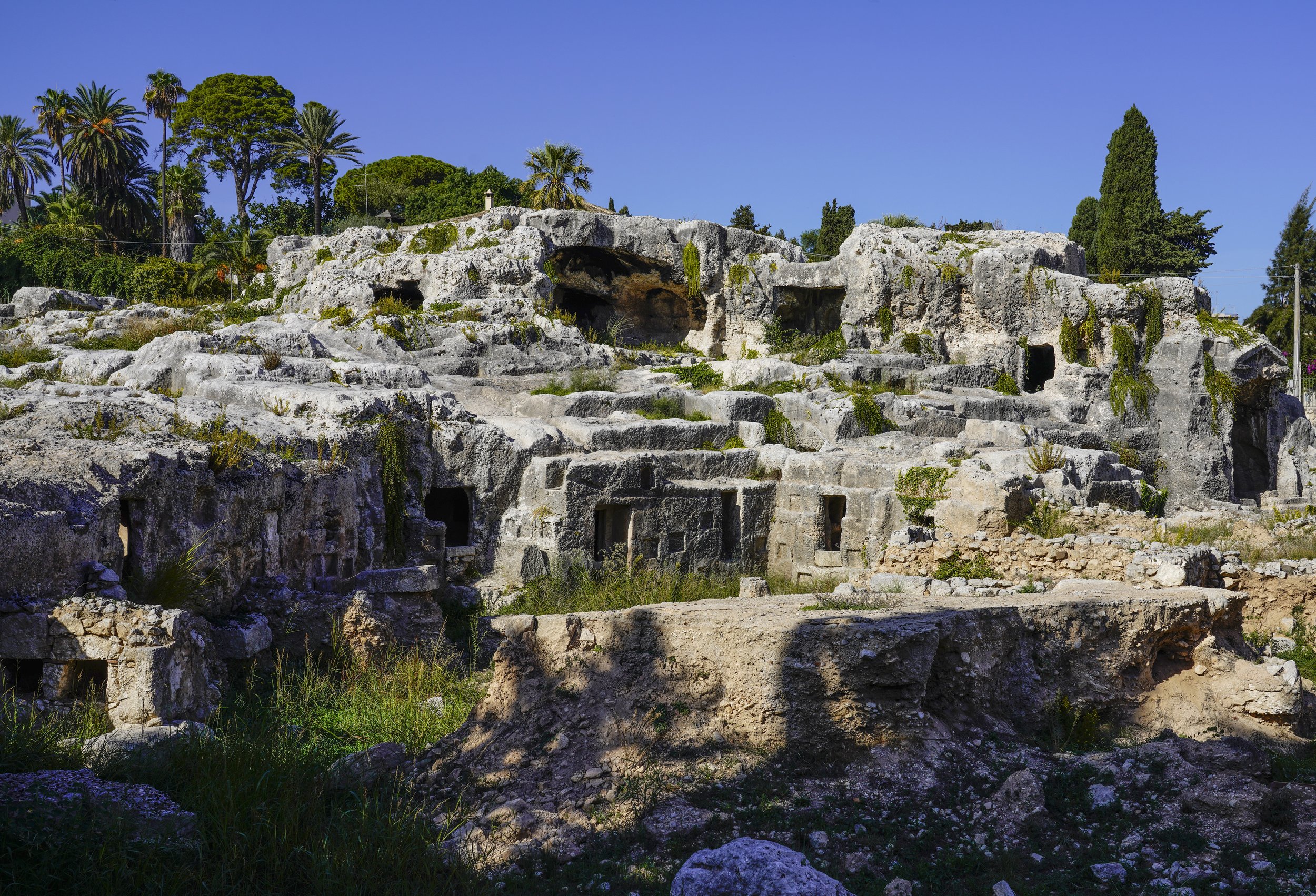
Carved into the limestone rocks in the area north of the Neapolis Archaeological Park, the Grotticelle Necropolis is a true “city of the dead”, containing graves from the Greek, Roman and Byzantine periods and an important testimony to Syracuse’s ancient history. The first burials date to the Bronze Age, but it was with the Greeks, in the 3rd century BCE, that the Necropolis reached the height of its splendor. After a period of neglect, it came back into use in the 1st century BC under the Romans as a columbarium with two tiers of niches for cinerary urns to be stored.
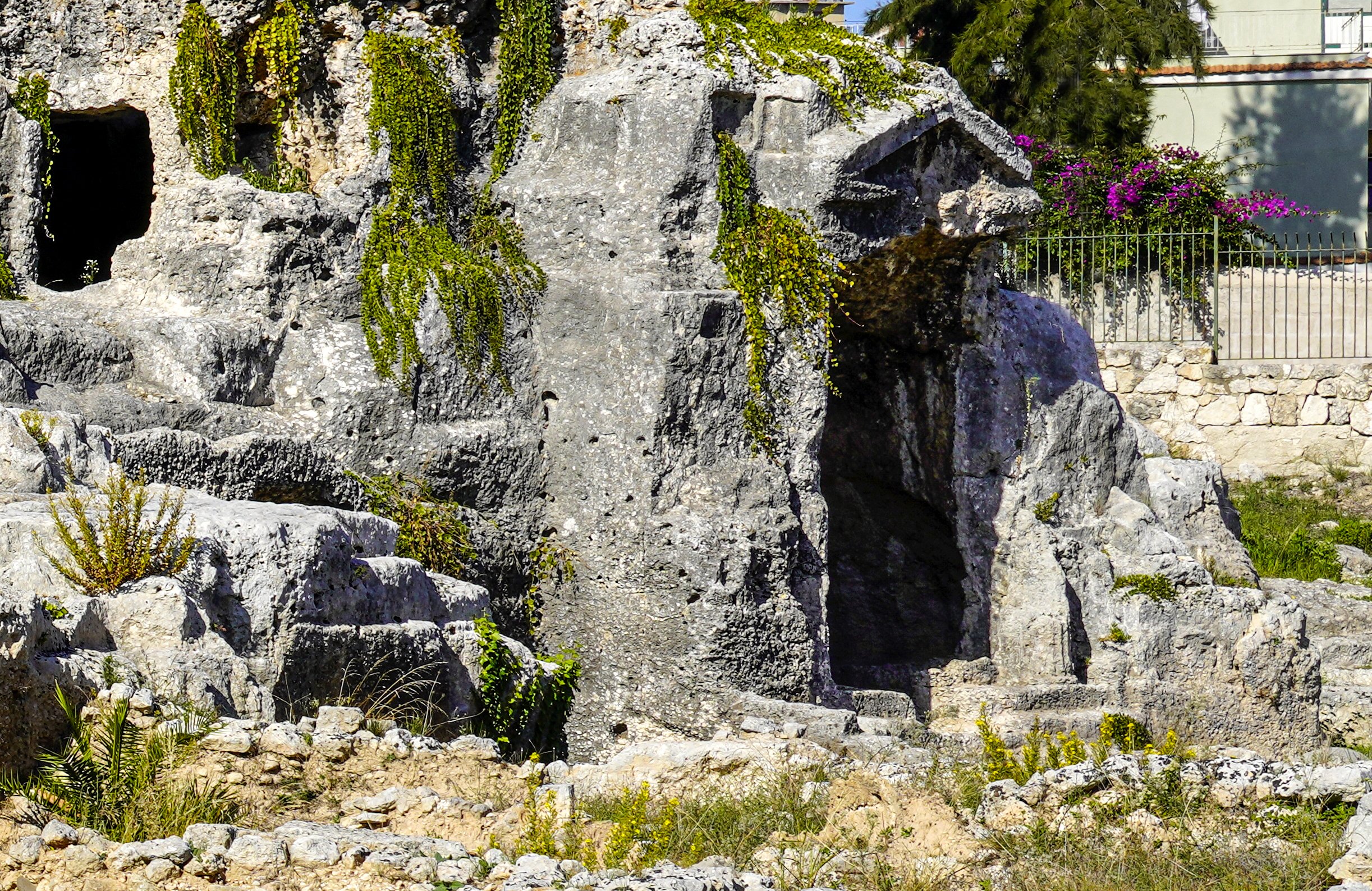
Among the many tombs carved into the limestone rock is the famous Tomb of Archimedes, distinguished by the arch over the tomb. Archimedes was a Greek engineer and inventor who is regarded as the greatest mathematician of antiquity and one the greatest of all time. He is credited with a number of inventions still in use today (such as the Archimedes screw) and is referred to as the father of mathematics and mathematical physics.
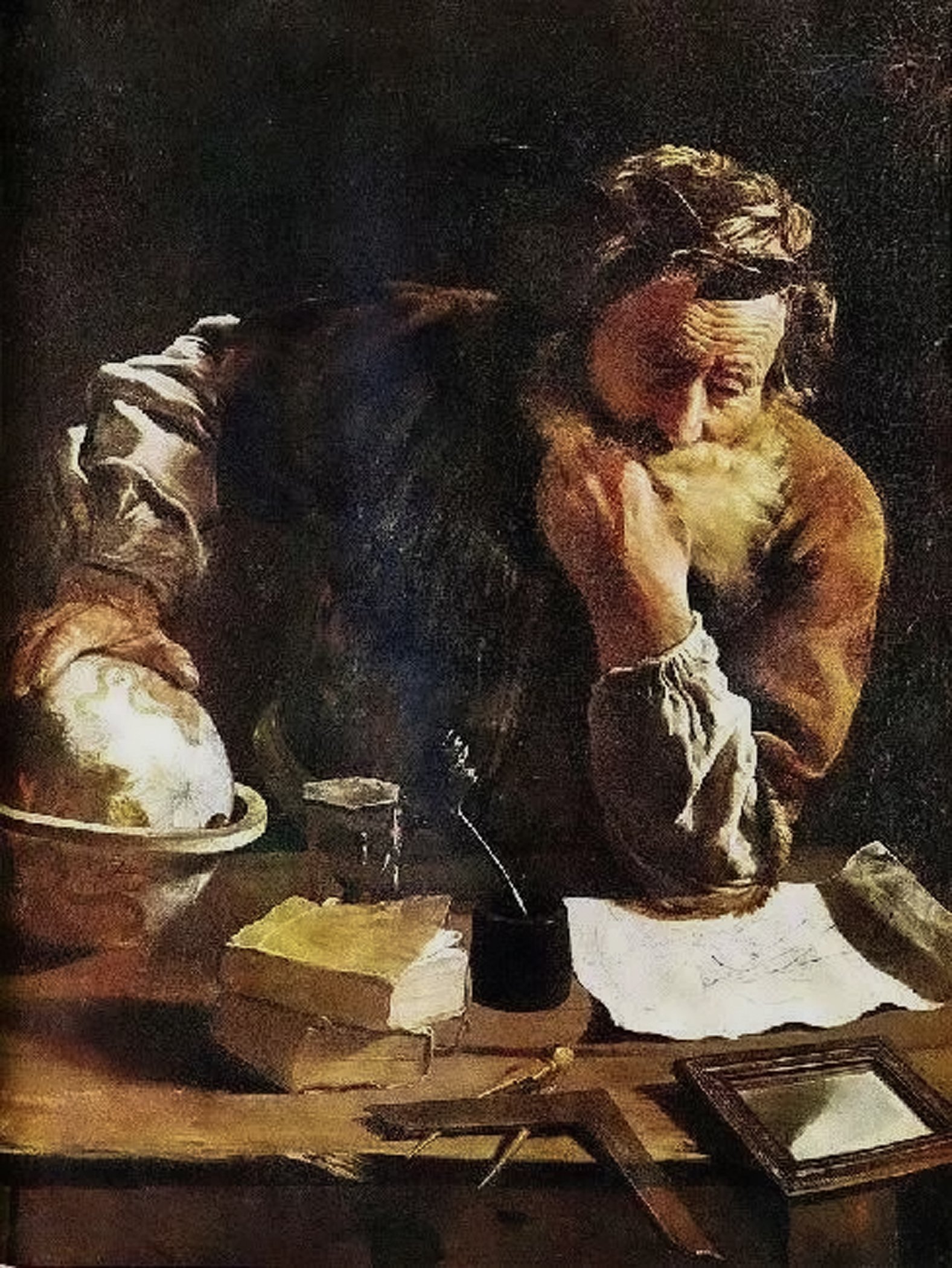
Archimedes is referred to as the father of mathematics and mathematical physics. His major theories included the fundamental principles of mechanics; methods for finding the center of gravity, surface area, and volume of geometric figures; the principle of buoyancy; and, of course, an estimate for the value of pi.
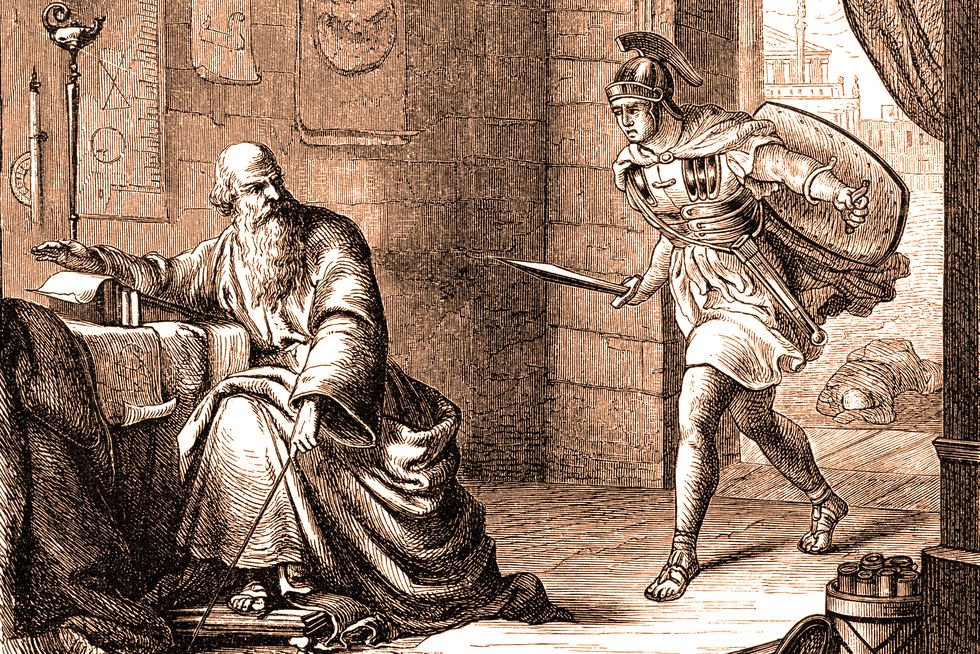
Archimedes is said to have been so completely absorbed by intellectual pursuits that he would frequently forget to eat or bathe. At the fall of Siracusa to the Romans in 212 BCE, he was assassinated by a Roman soldier, as he was so involved in his work on mathematics that he did not run even when the solder came to him. When the Romans invaded Siracusa, Archimedes’ “engines of war” helped defend the city. These devices included cranes to drop rocks, claws to lift ships from the water, and machines to fire wooden missiles. He also devised a set of mirrors that focused sunlight on enemy ships, setting them on fire.

The word latomia comes from the Greek words for stone and cut, and it indicates open-air jails which were full of prisoners and slaves back in the 5th century BCE. The inmates used to work in the caves to extract calcareous rock, which used to be used for almost all works of construction back in those days.


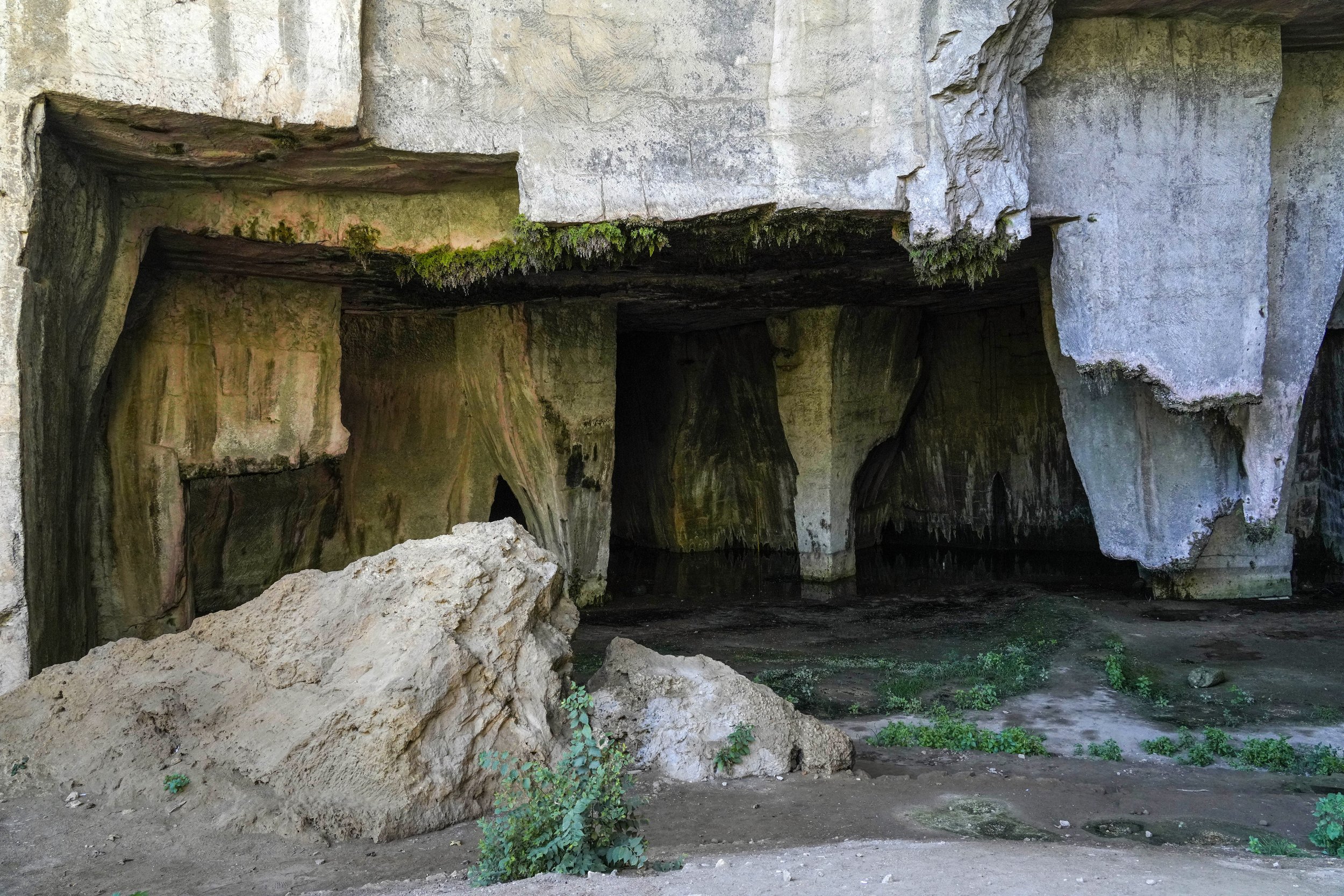

In the year 61 AD, during a stop on his way to Rome, the apostle Paul was said to have spoken to the Sracusans at the Latomie. In the work you can see the Saint preaching inside a cave, which clearly looks to be the Grotta dei Cordari, as seen from the slope of the walls, depicted as a backdrop. The Saint is portrayed with his right hand raised in the act of preaching, surrounded by his companions and a devout crowd who are listening attentively to him.
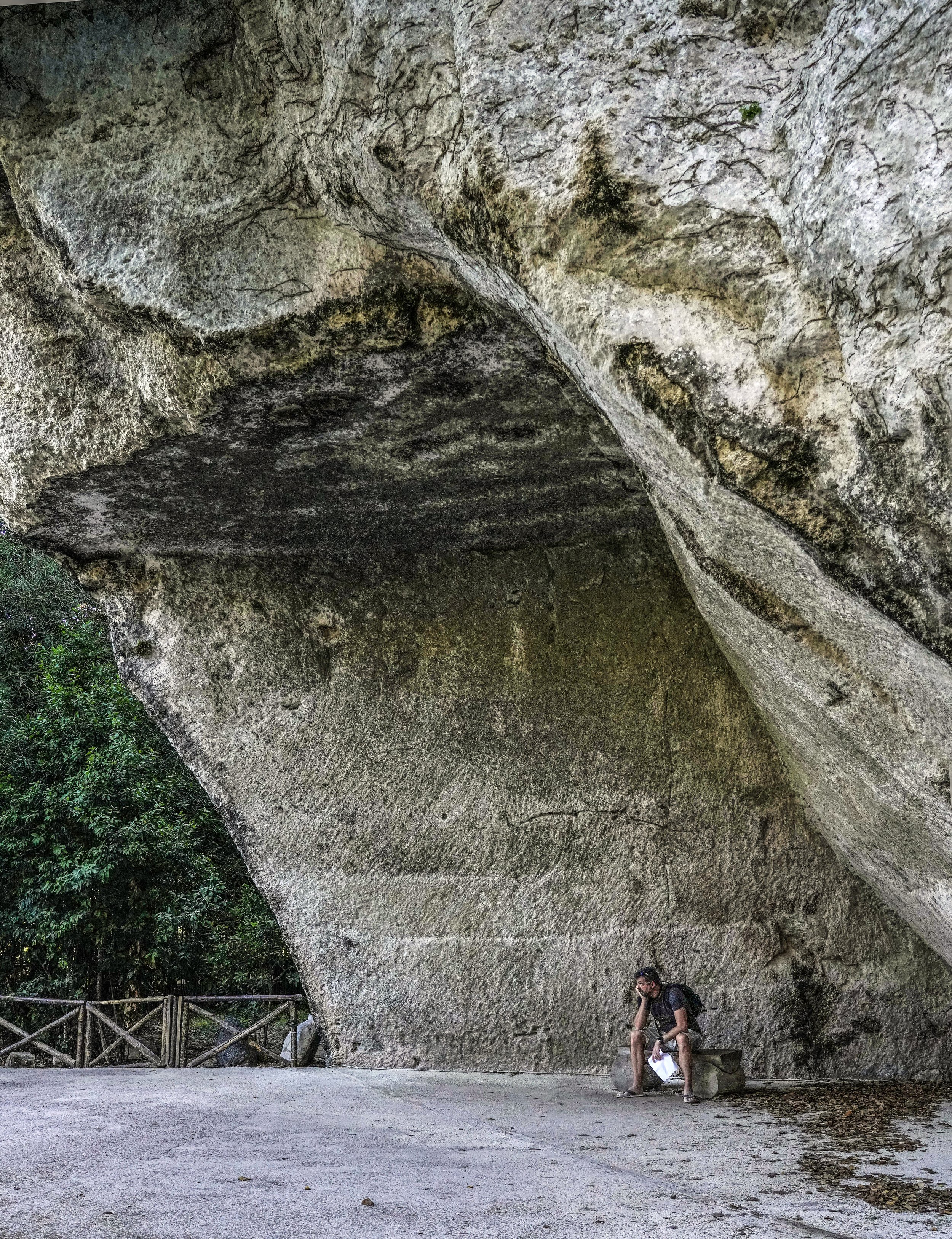

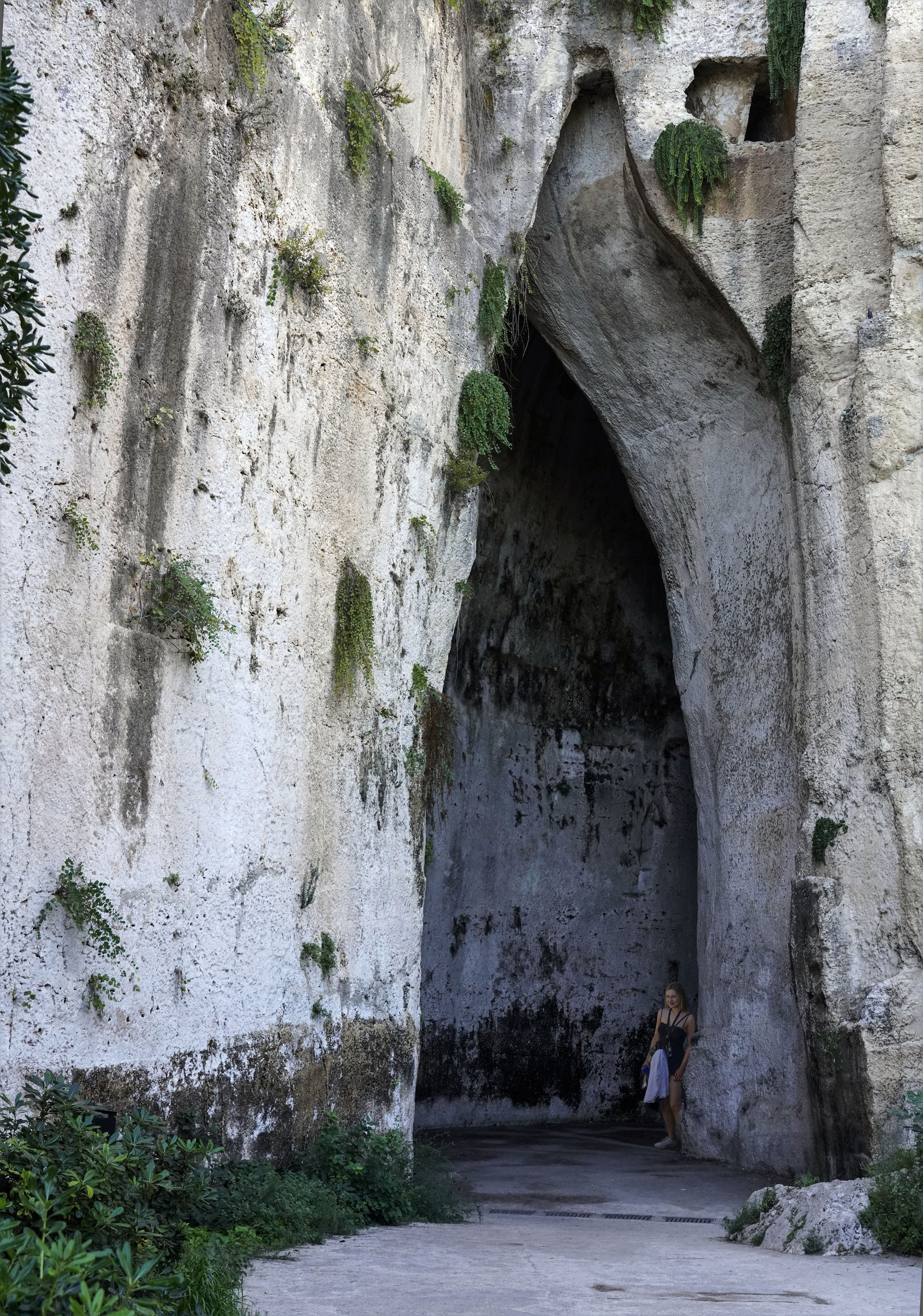
This cave was dug in Greek/Roman times to provide water storage for Siracusa. A narrow tunnel was dug first. This tunnel was widened by digging down and sideways afterwards, giving the cave its unusual shape. The small narrow tunnel is still visible on the top of this artificial cave. An earthquake struck this area causing damage, and the cave became unusable for water storage afterwards. The cave is featured as the location of the tomb of Archimedes in the 2023 film Indiana Jones and the Dial of Destiny.
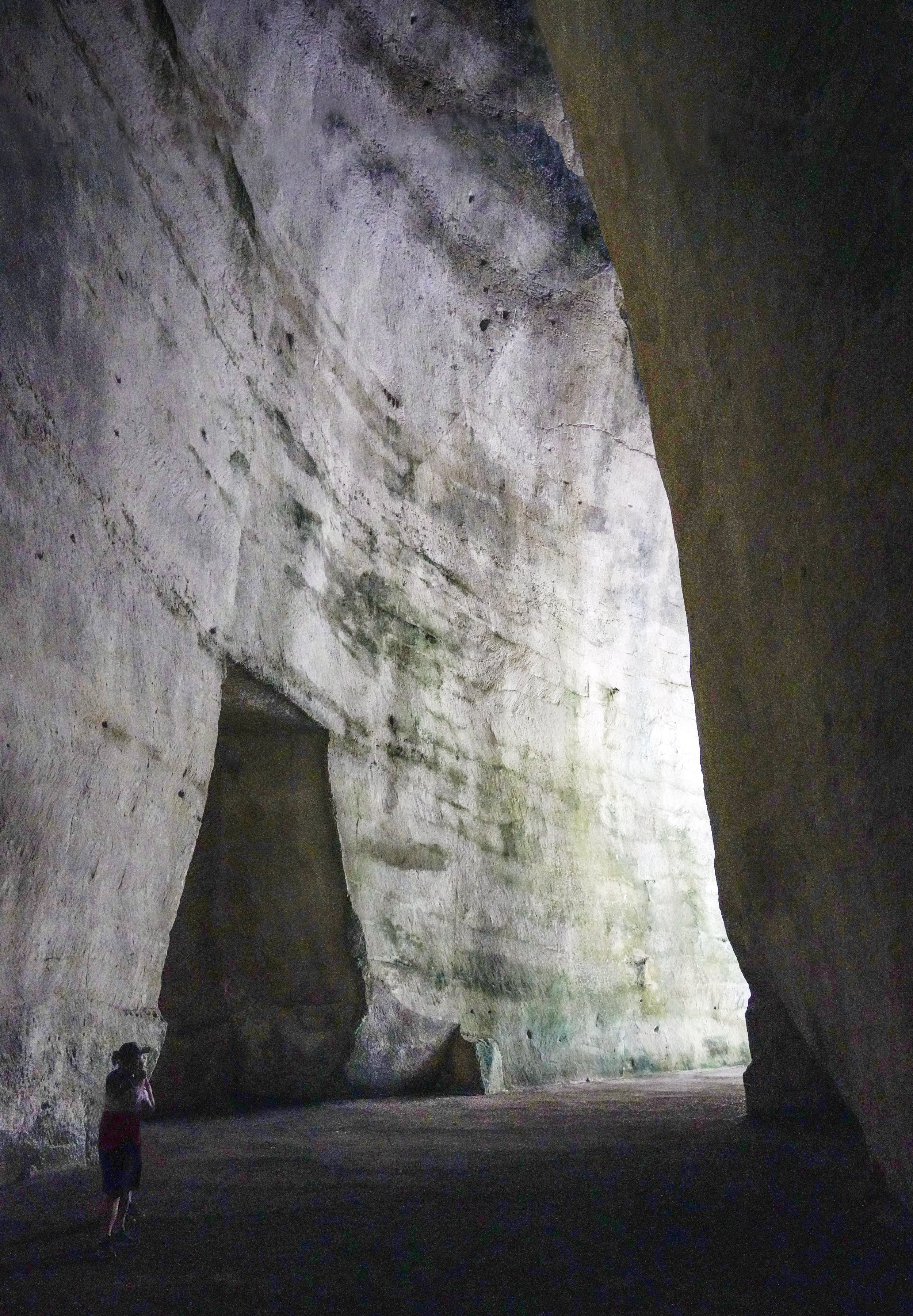
The Ear of Dionysius, from which the route of the large urban quarries starts, was most likely formed out of an old limestone quarry. It is 75.5 feet high and extends 213.3 feet back into the cliff. Horizontally, it bends in an approximate "S" shape, vertically it is tapered at the top like a teardrop (see previous photo). Because of its shape, the Ear has extremely good acoustics, making even a small sound resonate throughout the cave.

The name of the cave was coined in 1608 by the painter Caravaggio, who was shown the grotto by the mathematician, antiquarian and archaeologist Vincenzo Mirabella. It refers to the tyrant Dionysius I of Siracusa. According to legend, Dionysius used the cave as a prison for political dissidents, and by means of the perfect acoustics eavesdropped on the plans and secrets of his captives. Another legend claims that Dionysius carved the cave in its shape so that it would amplify the screams of prisoners being tortured in it.
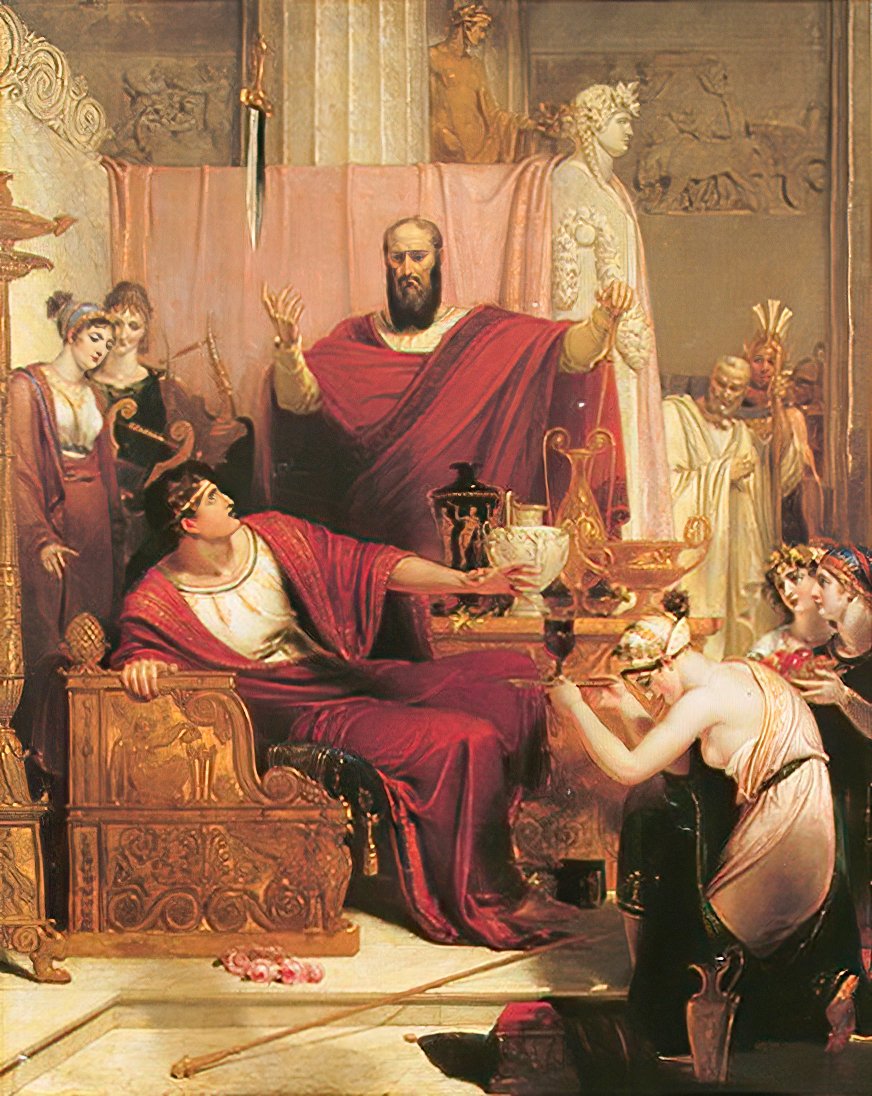
The picture basically tells a story of “walk a mile in my shoes.” Damocles admired the tyrant Dionysius (c. 432 BC – 367 BC) for what he perceived was a life of splendor and power. Damocles expressed how ‘fortunate’ Dionysius was, to which Dionysius replied, “So, Damocles, since this life delights you, do you wish to taste it yourself and make trial of my fortune?" Damocles said that he desired this, not realizing that power often came with an actual life dominated primarily by fear: e.g., being afraid that someone will kill him, either to eradicate the tyranny or to become tyrant themselves. Later, while Damocles was enjoying all the trappings of a luxurious life in Dionysius’ palace, the later ordered that a shining sword, fastened from the ceiling by a horse-hair, be let down so that it hung over the neck of that ‘fortunate’ man. Realizing his precarious situation, Damocles begged Dionysius that he should be allowed to depart because he no longer wanted to be ‘fortunate.’
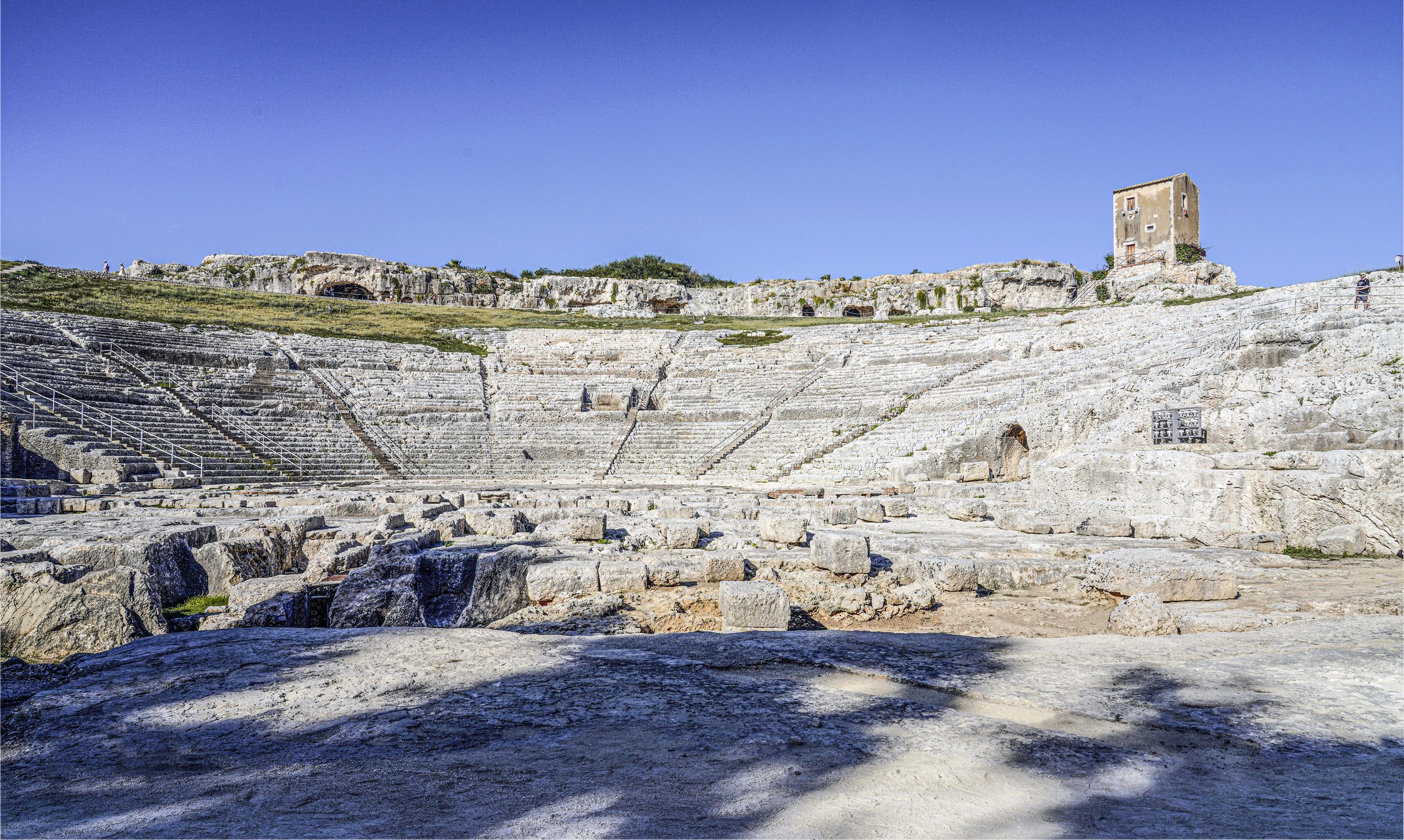
The Greek Theater of Siracusa was first built in the 5th century BCE, rebuilt in the 3rd century BC and renovated again in the Roman period. In antiquity it had great international fame and prestige being the most important building for shows of the Greek-western world, a very high example of civil architecture. It was also a place of worship and large popular assemblies, the site of public trials and, in Roman times, it was also adapted for circus and variety exhibitions. Today, it is a part of the Unesco World Heritage Site of "Siracusa and the Rocky Necropolis of Pantalica".
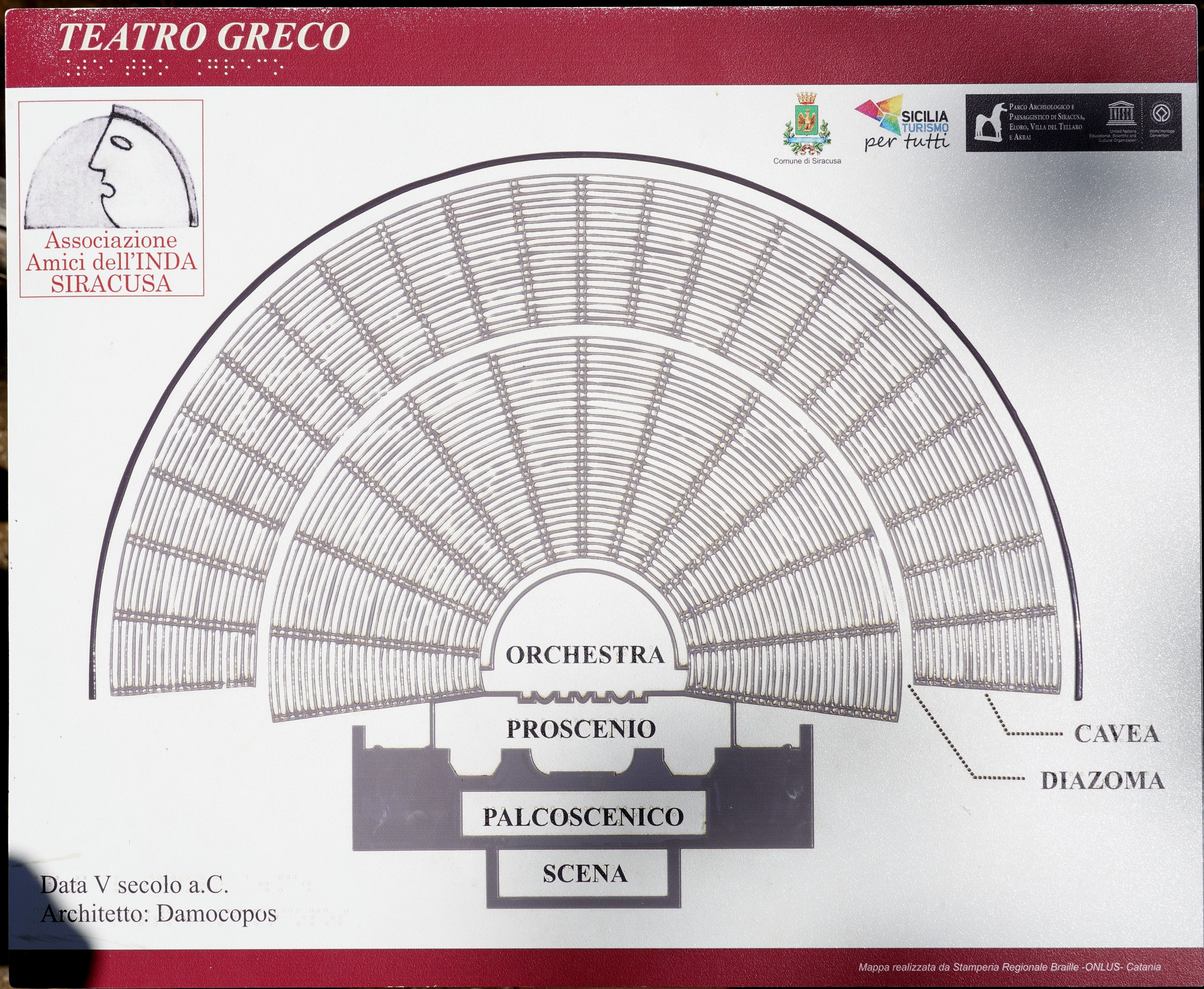
The Greek Theater of Siracusa can house 15,000 to 16,000 people, originally had 67 orders of steps, 21 of which were large square-shaped boulders that were removed in the 16th century by the Spaniards on behalf of Charles V (b. 2/24/1500 – d. 9/21/1558), Emperor I King of Spain, King of Naples and the last “real ruler” of the Holy Roman Empire, for the fortifications of Ortigia (Siracusa area) and the remaining 46 are carved directly into the rock.
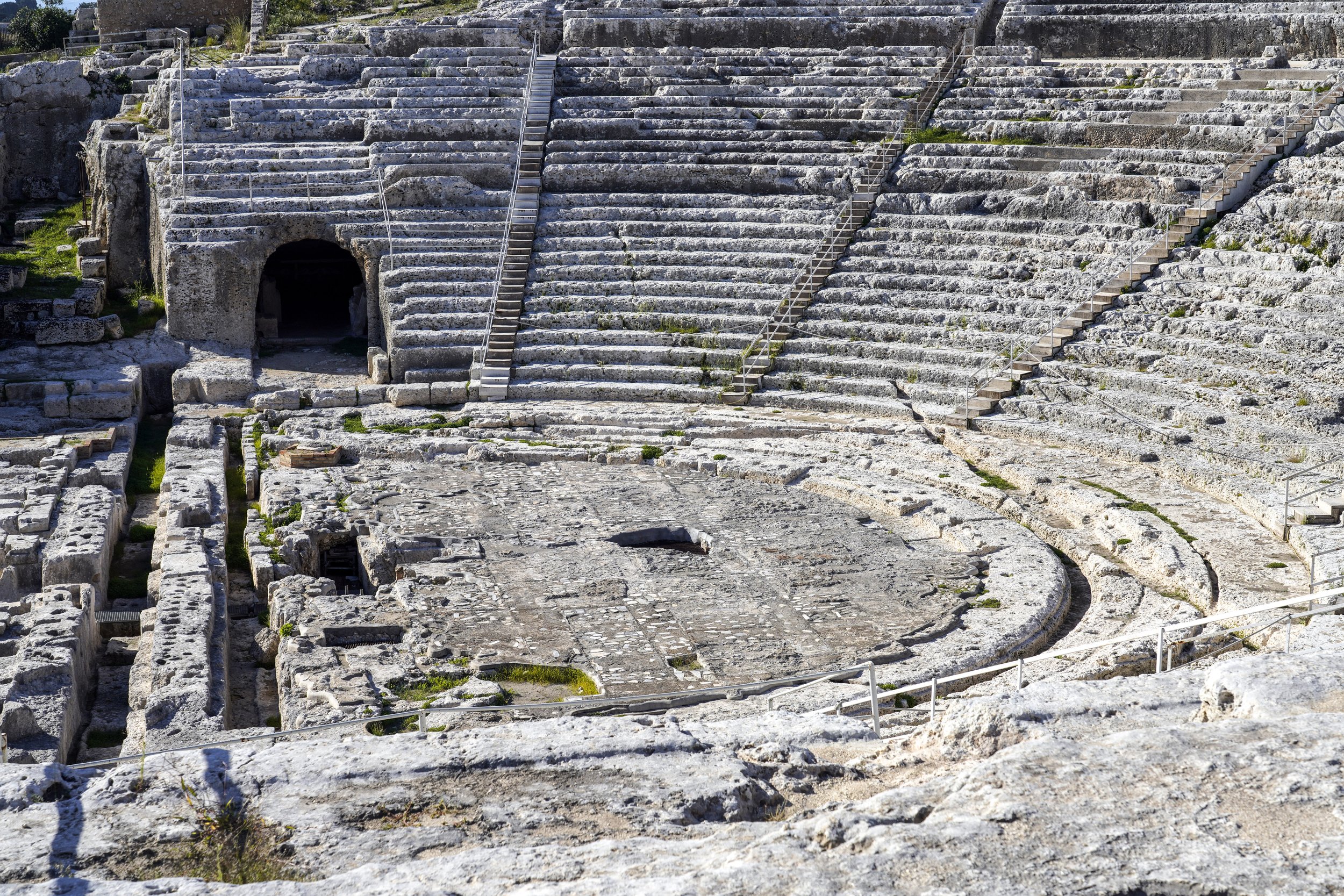
At the end of the staircase, in the lowest level of the Greek Theatre, there is the semicircular orchestra that was intended to house the choir that at that time had the task of describing what was happening at that time because it often could not be represented on the scene (part located in the area behind the orchestra). The Greek Theater of Siracusa was one of the major centers of theatrical, political and spectacular life of the time.

Ancient Greek theater dates back to the 6th century BCE and was deeply rooted in religious and civic rituals. Nearly every Greek and Roman city of note had an open-air theater, the seats arranged in tiers with a view of the surrounding landscape. Here the Greeks sat and watched the plays first of Aeschylus, Sophokles, Euripides, and Aristophanes, and of Menander and the later playwrights.
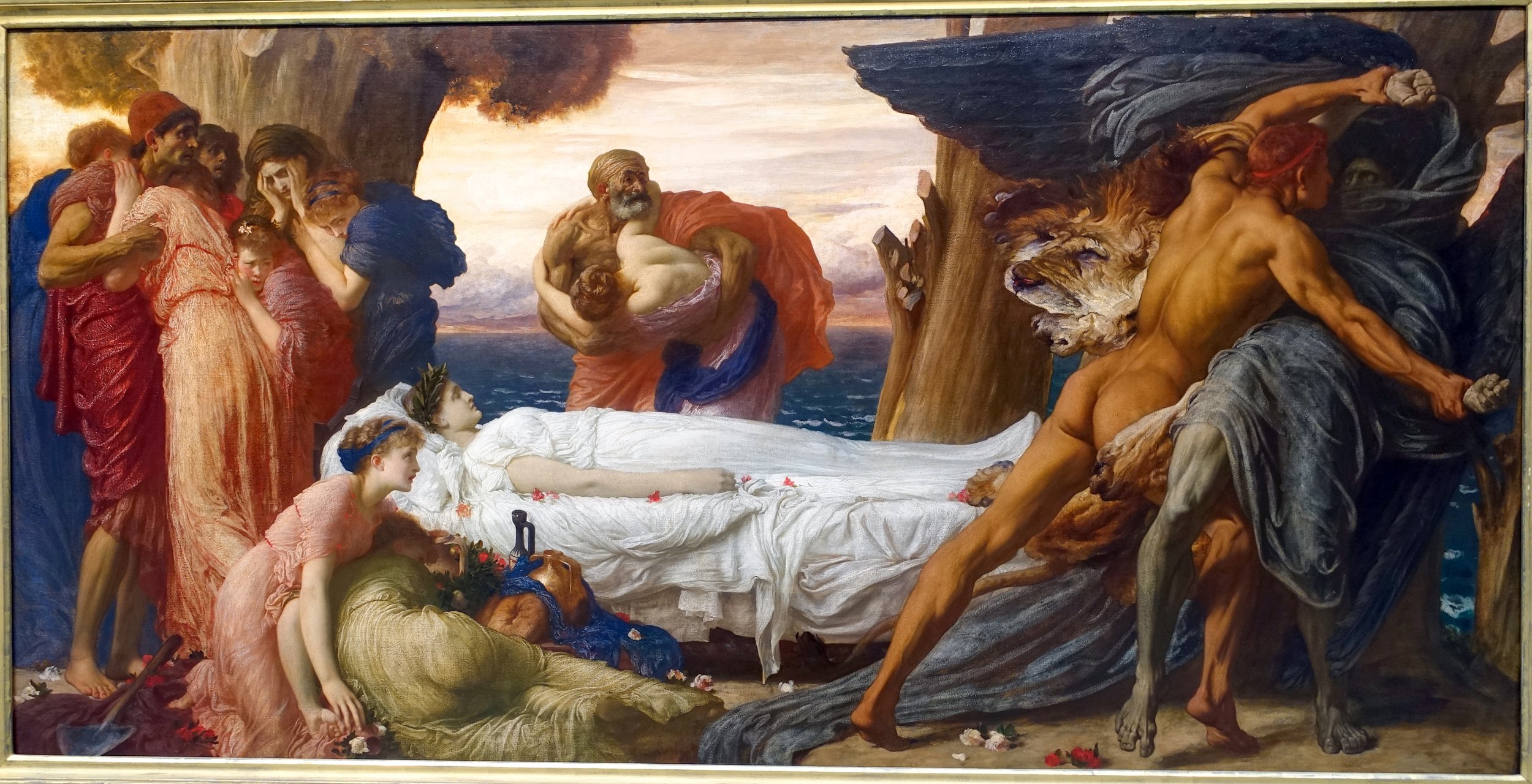
Greek theater goers would see plays such as the tragedy Alkestis by Euripides, which was originally performed in Athens at the City Dionysia in 438 BC. With much drama the play begins with Alkestis’s death and ends with the hero Herakles (Heracles) wrestling Thanatos, the divine personification of death, for her soul and bringing her back to life. He then brings her as a veiled woman to Admetus, her husband, and asks him to take her and look after her while he is away on his labors. When Admetus lifts the veil, he finds it is Alcestis, back from the dead. Heracles has battled Death and forced him to give her up.
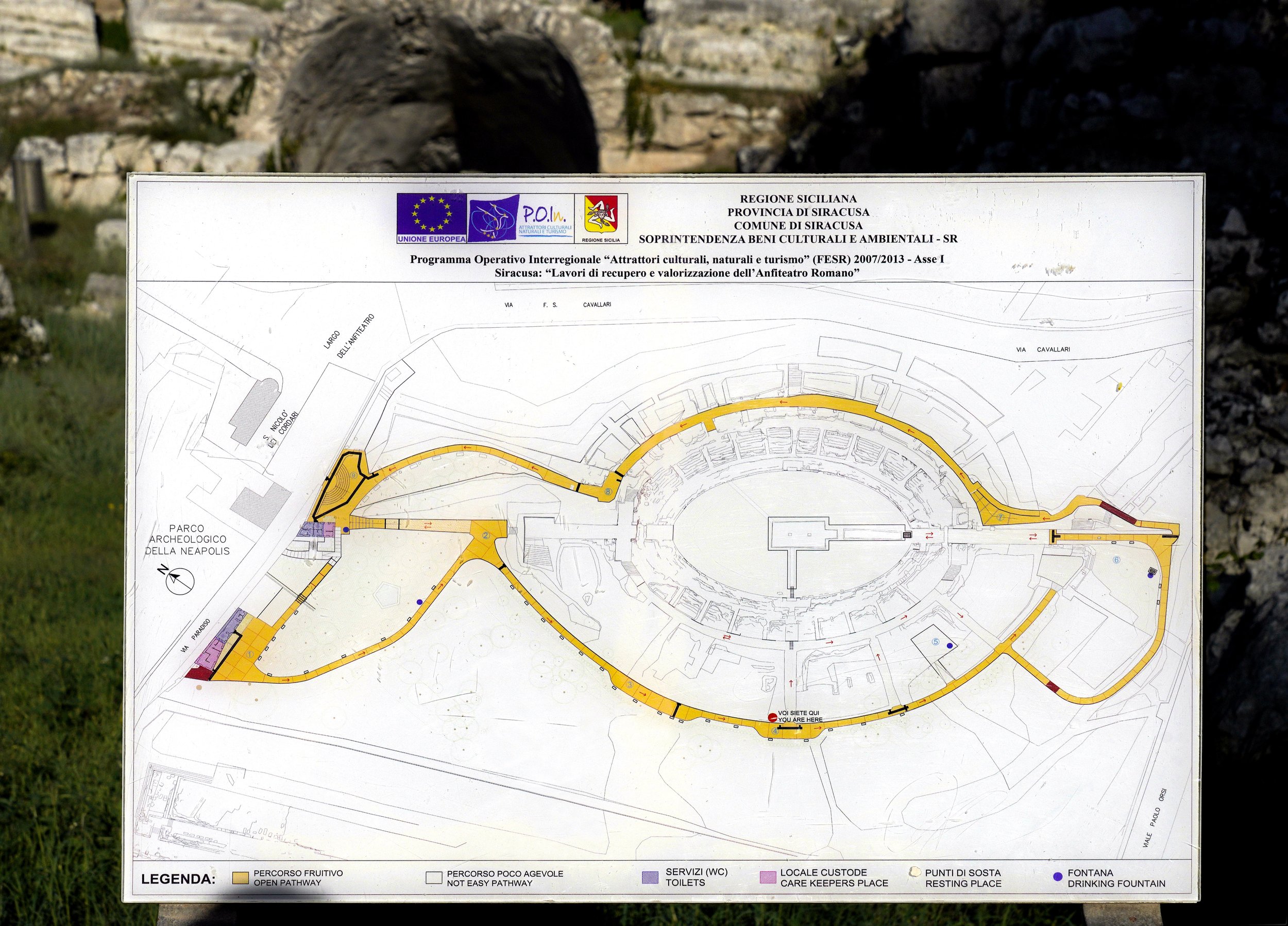
The Roman Amphitheater, perhaps begun under the reign of Nero (Roman emperor), was built between the second half of the second and fourth centuries AD., but for years it remained buried and was only brought to light in 1839 by the Duke of Serradifalco (a scholar, architect and scholar of Sicilian archaeology and architecture).
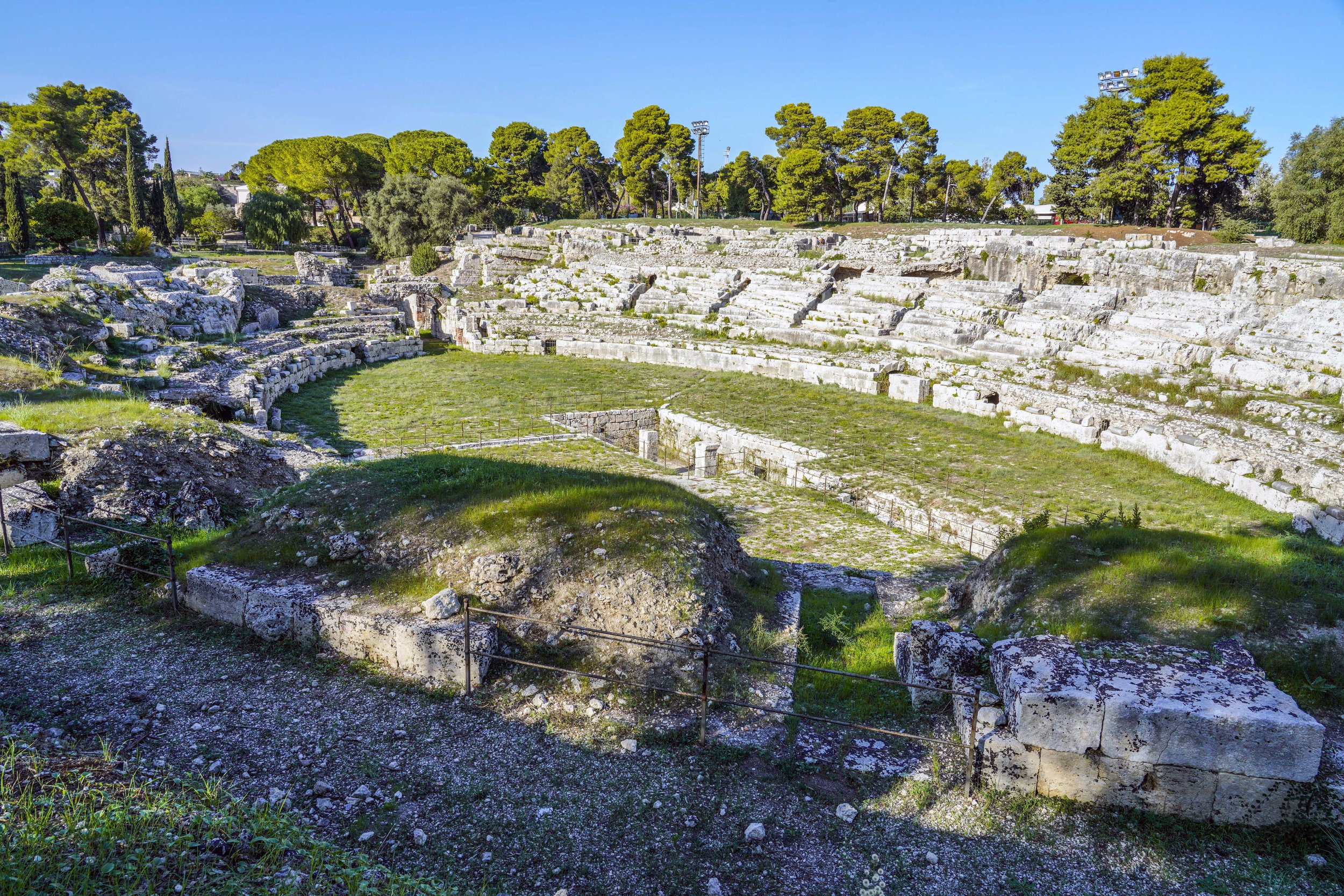
This 2nd-century Roman amphitheater was originally used for horse races and gladiatorial combats. The amphitheater is located in the ancient suburb of Neapolis, measuring around 450 feet (length ) by 390 feet (width). The seating in the cavea is separated from the arena itself by a high platform, under which was a vaulted corridor through which gladiators entered the arena. Above this were the front seats, which were reserved for high ranking individuals.
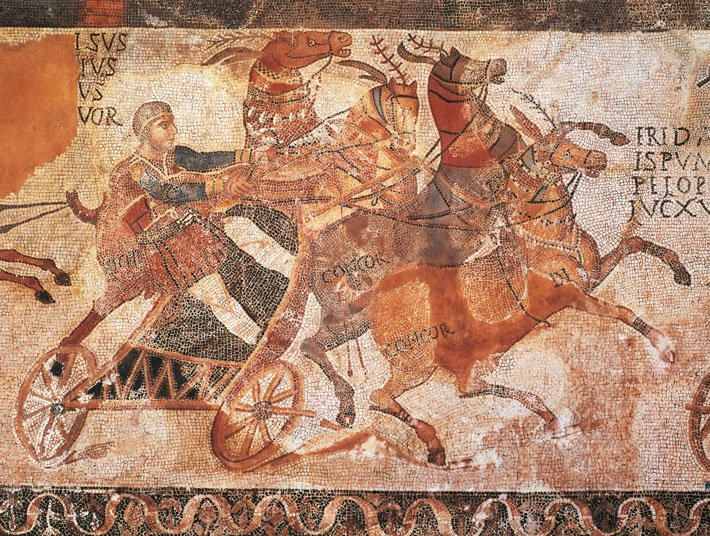
"A two-wheeled chariot," wrote journalist Lionel Casson in Smithsonian magazine, "was …pulled by a team of four horses that would be driven at the fastest gallop they could generate. They made 12 laps around the course — about nine kilometers — with 180 degree turns at each end. …viewers enjoyed not only the excitement of the race but the titillation that comes from the constant presence of danger: as the teams thundered around the turns, or one chariot tried to cut over from the outside to the inside, crashes and collisions were common and doubtless often fatal. In one celebrated race in the Pythian games, the competition was so lethal that only one competitor managed to finish!" [Lionel Casson, Smithsonian, February 1990]
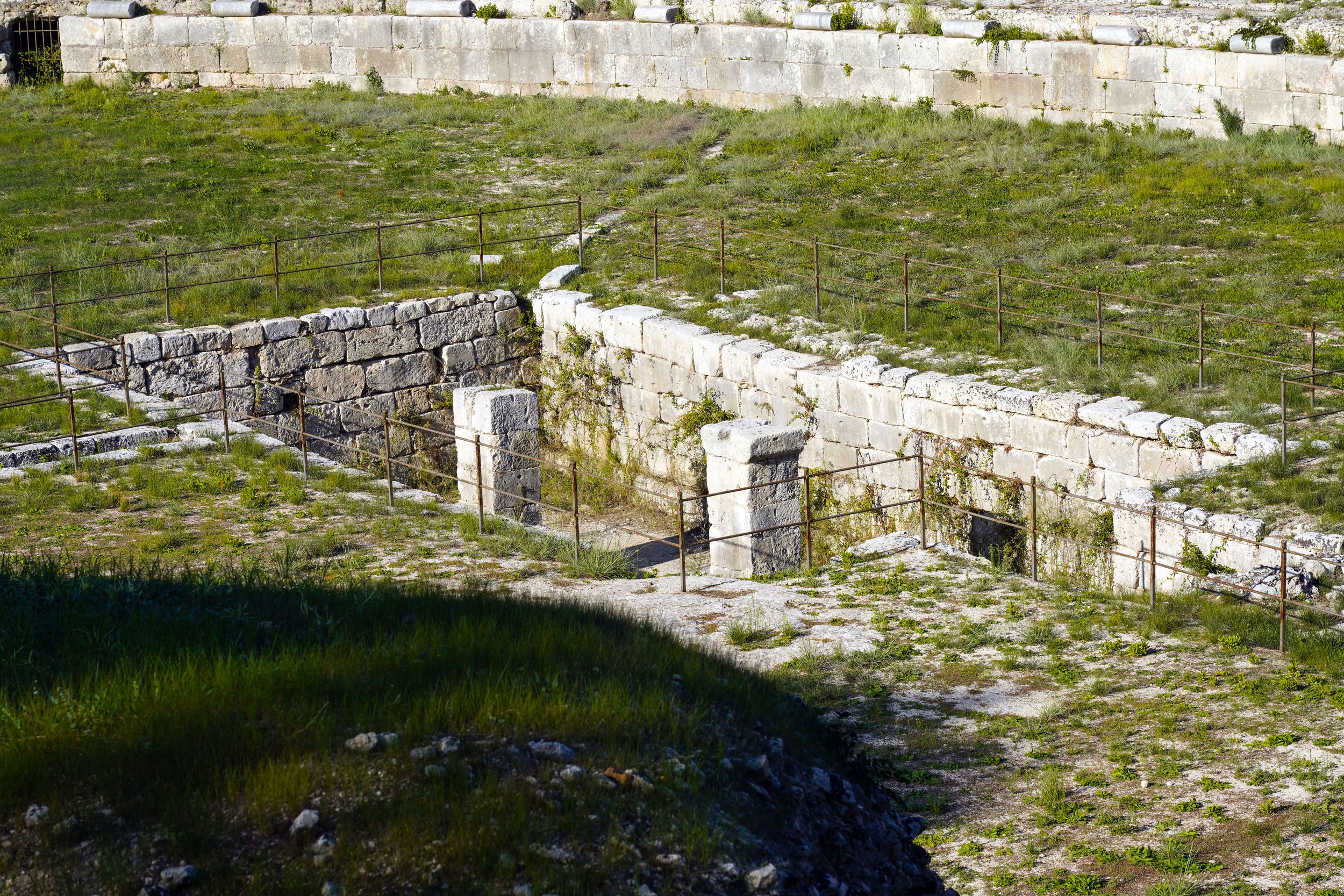
At the centre of the arena there was a rectangular pit, which was originally covered. An underground passage ran from this pit to the entrance at the southern end of the amphitheater. This pit and passage were necessary for machinery used during the shows.
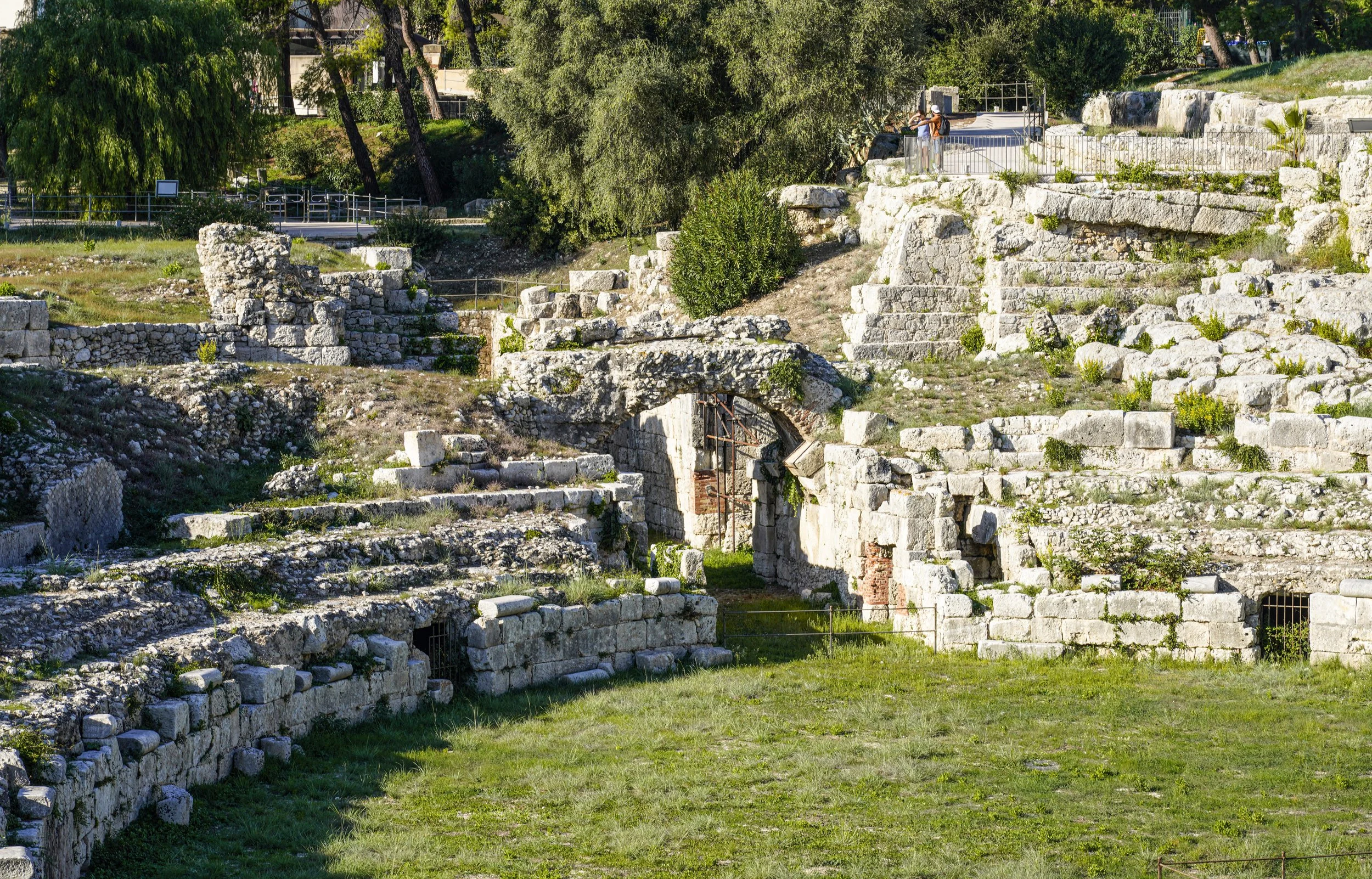
The amphitheater had two entrances and a complicated system of steps which led from the upper levels to the exterior. The cavea (steps for spectators) is dug in part into the rock of Colle Temenite (natural rock on which the entire Archaeological Park is based) and in part formed by blocks that were later used by the Spanish to fortify the city of Syracuse, in fact, the Spanish plundering of the sixteenth century have completely destroyed the raised part of this amphitheater.
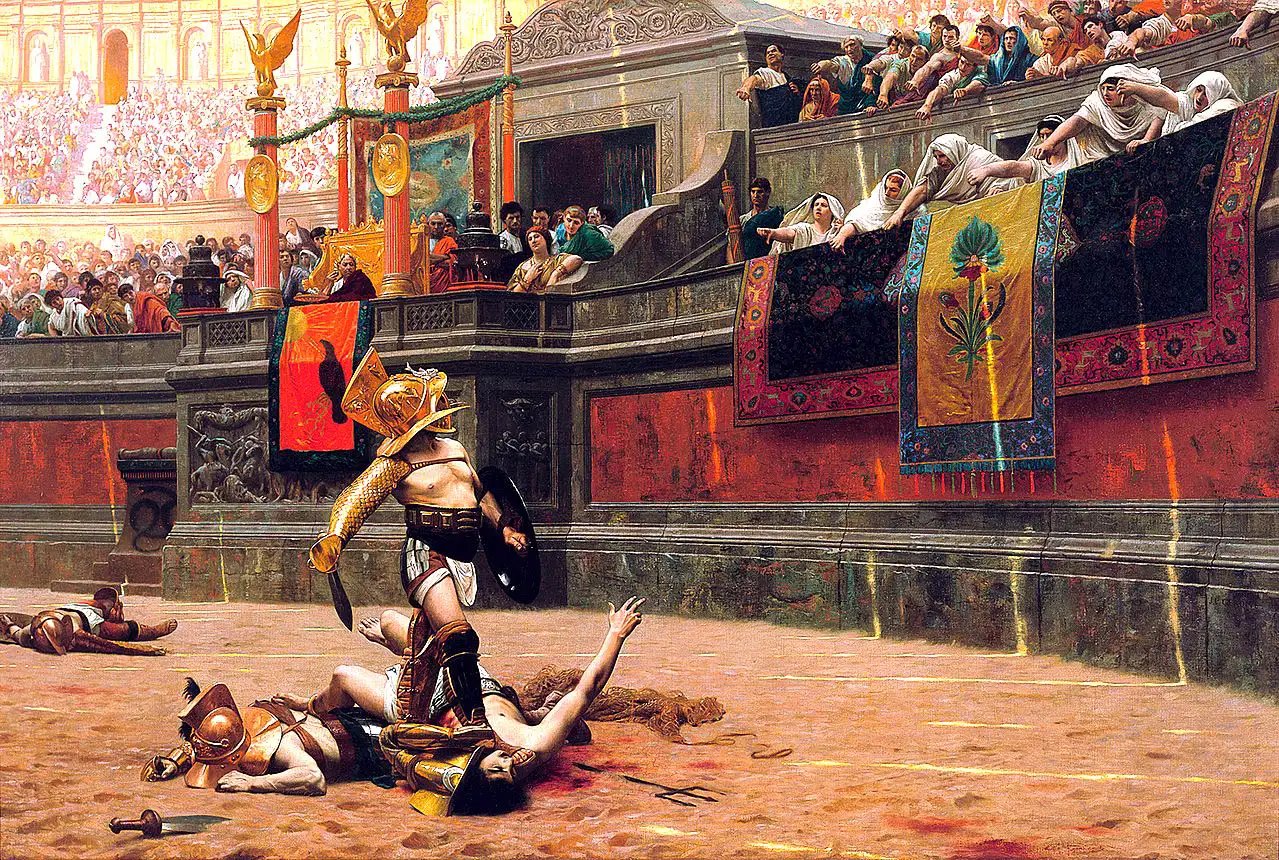
The Roman amphitheater was a multipurpose building dedicated to mass entertainment. Their repertoire varied, encompassing all sorts of violent sports. The most common were gladiatorial fights, where professionally trained athletes competed in hand-to-hand combat in front of a frenzied audience. Contrary to traditional beliefs, the gladiators rarely fought to the death. For every ten gladiators who entered the ring, nine probably lived to fight another day. The best gladiators would gain both glory and wealth, becoming ancient superstars.
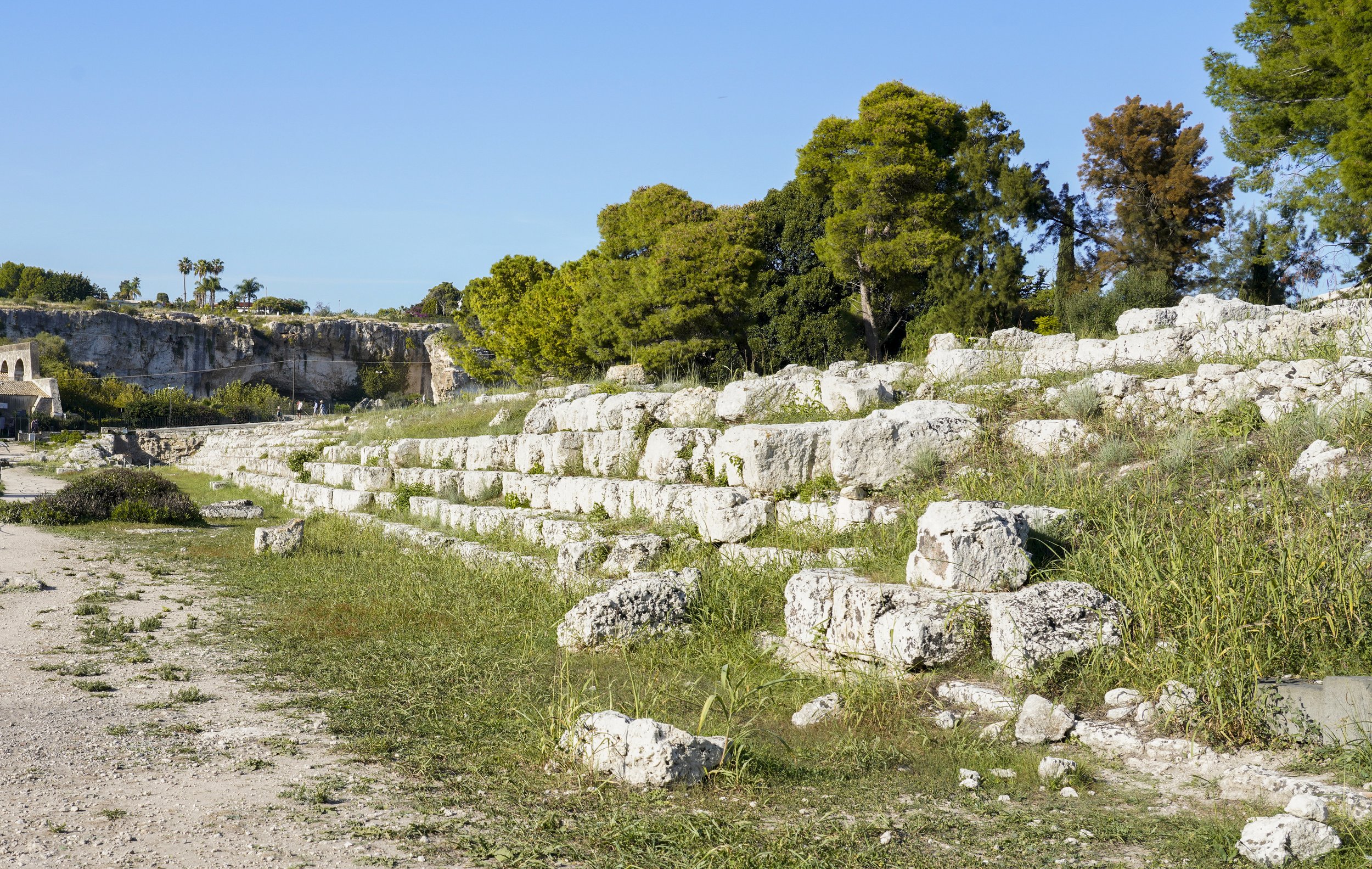
The Altar of Hieron (Italian: Ara di Ierone) was built in the Hellenistic period in Magna Graecia by King Hiero II (circa 235 BC. and is the largest altar known from antiquity. The enormous structure is nearly 219 yards long (an olympic stadium according to the measurements of the time), 24 yards wide and roughly 16 yards tall, but what is left today, unfortunately, is only the base of the structure, carved out of the bedrock of the Colle Temenite. The altar was destroyed when the Spanish plundered it for building materials for the city.

The monumental Altar of Hieron was built to commemorate the fall of Trasibulus in 466 B.C. and was dedicated, most probably, to Zeus Eleutherios (the Liberator), as commanded by the then tyrant Hieron II. Diodorus Siculus (Ist century B.C.) tells us that once a year, 450 bulls were simultaneously sacrificed in honor of Zeus. The corpses of the animals were then believed to have been burned at another raised platform in the center of the altar.
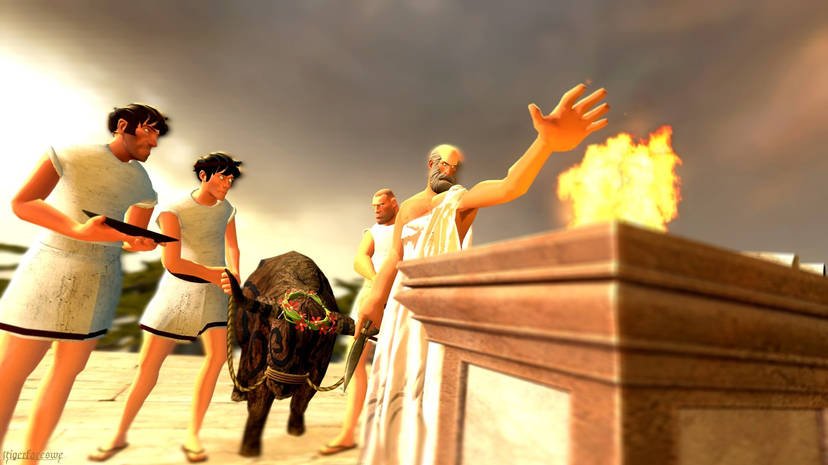
During the sacrifice to the gods or heroes, the animals would be slaughtered on an altar and then the carcasses would be prepared and roasted on a spit or boiled in a large pot over a fire. The ritual, including the shared meal, was also important for community cohesion. Most Greeks were relatively poor and it is not unlikely that one of the only times the average person had the opportunity to eat meat was at an animal sacrifice such as the one to Zeus the Liberator. While these were solemn events, the people of Siracusa looked forward to these rituals as part of their annual calendar.

Bulls were used in the annual festival sacrifice to Zeus the Liberator, as the bull was a symbol of strength in ancient Greece and some believed that bull’s blood had certain magical properties. The Greeks believed that gods and heroes demanded sacrifice as part of their worship. The sacrifices often, but not always, took the form of live animals, typically goats, pigs, or other common farm animals.
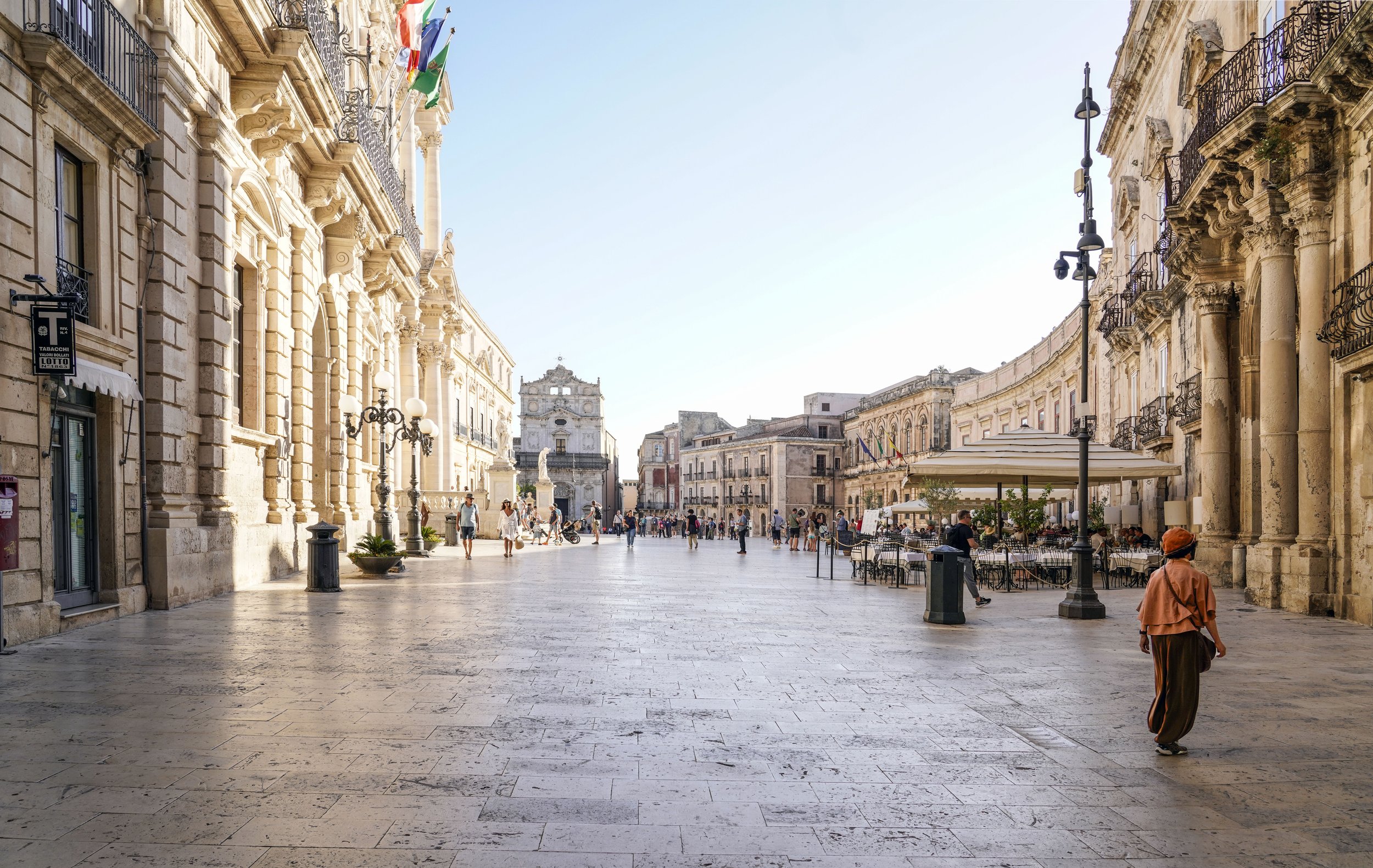
Piazza del Duomo is the main square of Siracusa, located in the historical center of the city, on the island of Ortygia. The semielliptical square gathers many beautiful Baroque buildings. To the south of the square, there is the Church of Santa Lucia alla Badia, dedicated to the patron saint of Siracusa, Saint Lucia. The church was built between 1695 and 1703, after a design by the architect Luciano Caracciolo.

A church and monastery at this site, attached to a female Benedictine monastery was present by the mid-15th century, generally thought with the patronage or Queen Isabelle of Spain (1451 – 1504). It was supposedly built at the site at which St Lucy officials unsuccessfully attempted to force her into prostitution. The monastery and church were destroyed by the 1693 Sicily earthquake. When the present church was reconstructed the facade was transferred to face the piazza Duomo, the site of more religious celebrations.
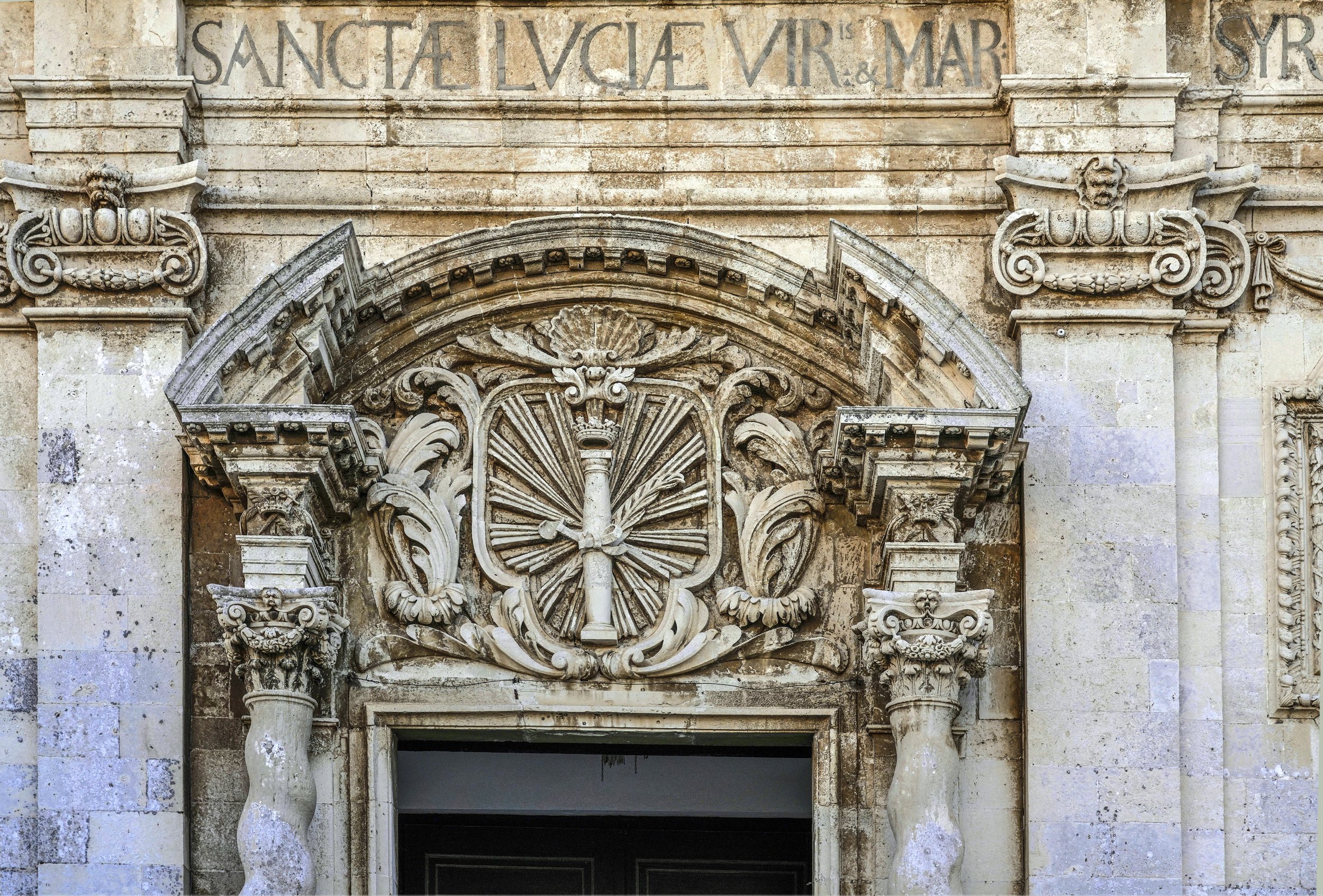
The facade of St Lucia is decorated just above the main portal with symbols of the martyred patron of Siracusa, St Lucy; these include a column, a sword, a palm, and a crown. A dagger symbolizes how the Roman soldiers finally killed the virgin martyr with a sword. The crown symbolizes the wreath of candles she wore on top of her head to light the way, needed, according to legend, for her to carry food and water to Christians who had been forced to hide out in the dark catacombs of Rome. The palm illustrates Lucy’s victory over evil.
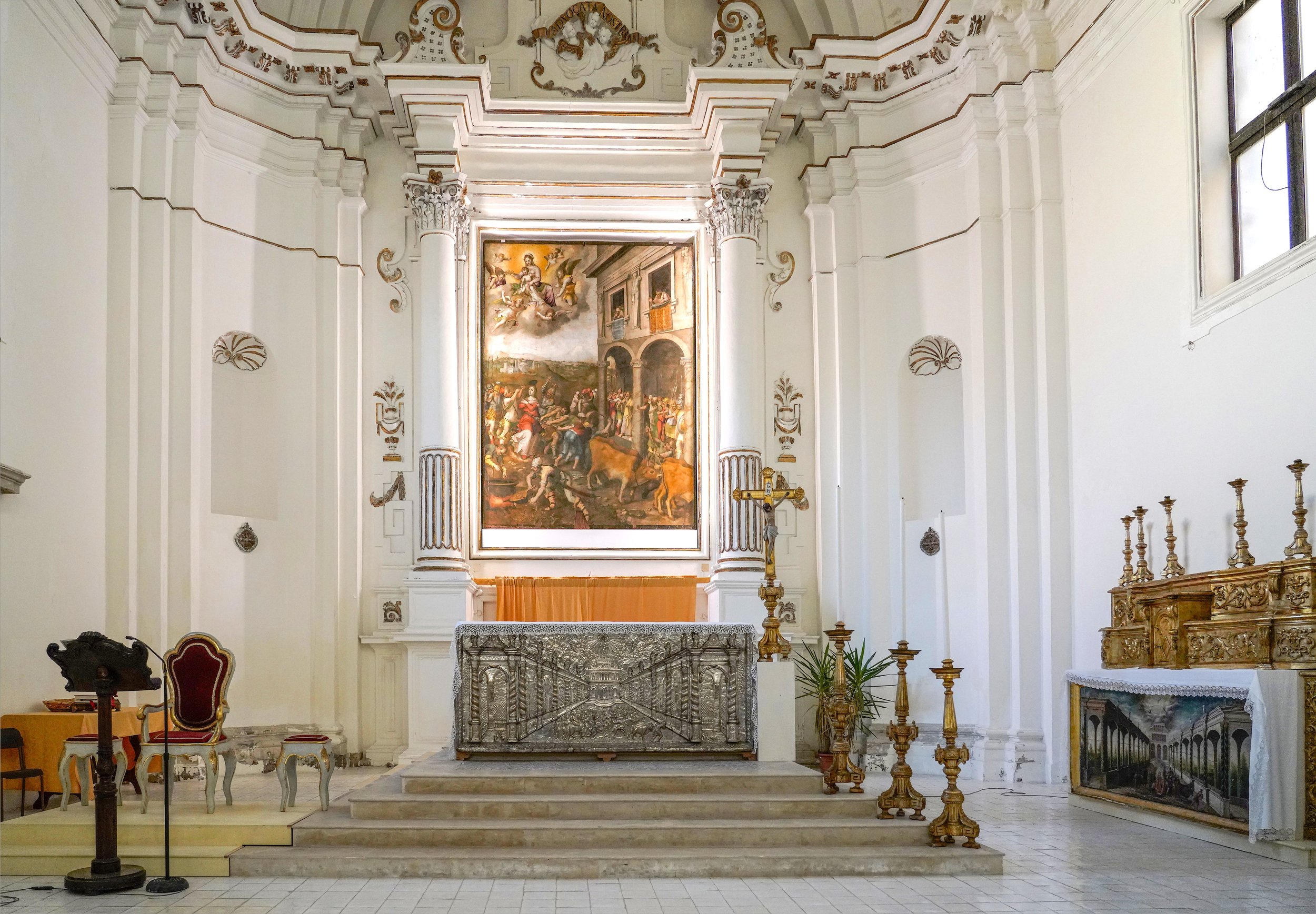
On the altar is an oil on panel painting, Saint Lucia Led to Martyrdom by Deodato Guinaccia (1579) and below the altar a panel entitled the Martyrdom of Santa Lucia. Lucy was probably a victim of the wave of persecution of Christians that occurred late in the reign of the Roman emperor Diocletian (284–305 CE). References to her are found in early Roman sacramentaries and, at Siracusa, in an inscription dating from 400 CE. As evidence of her early fame, two churches were dedicated to her in Britain before the 8th century, at a time when the land was largely pagan.

According to legend, Lucy came from a wealthy Sicilian family. Spurning marriage and worldly goods, however, she vowed to remain a virgin in the tradition of St. Agatha. An angry suitor reported her to the local Roman authorities, who sentenced her to be removed (rope) to a brothel and forced into prostitution. This order was thwarted by divine intervention; Lucy became immovable and could not be carried away. She was next condemned to death by fire (pitch), but she proved impervious to the flames. Finally, her neck was pierced by a sword {dagger) and she died in Siracusa, Sicily, in the year 304 CE.

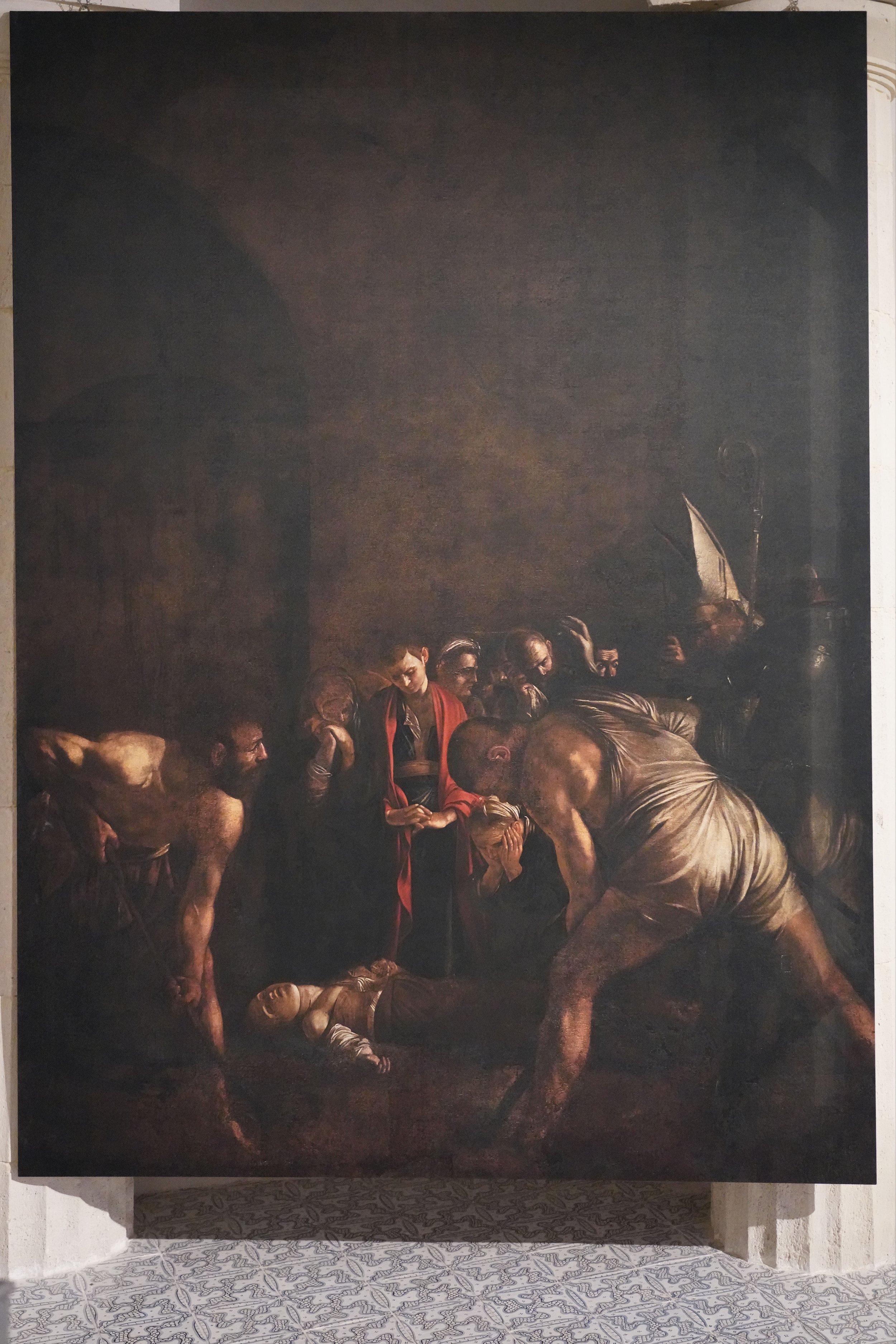
Caravaggio’s style is clearly recognizable: dark colors in the background and figures emerging from the light; in the foreground, two men prepare the burial for the Saint. Lying on the ground the body of the martyr, who seems almost asleep, were it not for the almost invisible cut in the throat. Alongside, some of the people cry moved by the death of Saint Lucy. Among them we can recognize a bishop and the painter’s self-portrait. The Siracusans, in fact, have always considered the canvas as a relic to which one can turn their prayers.
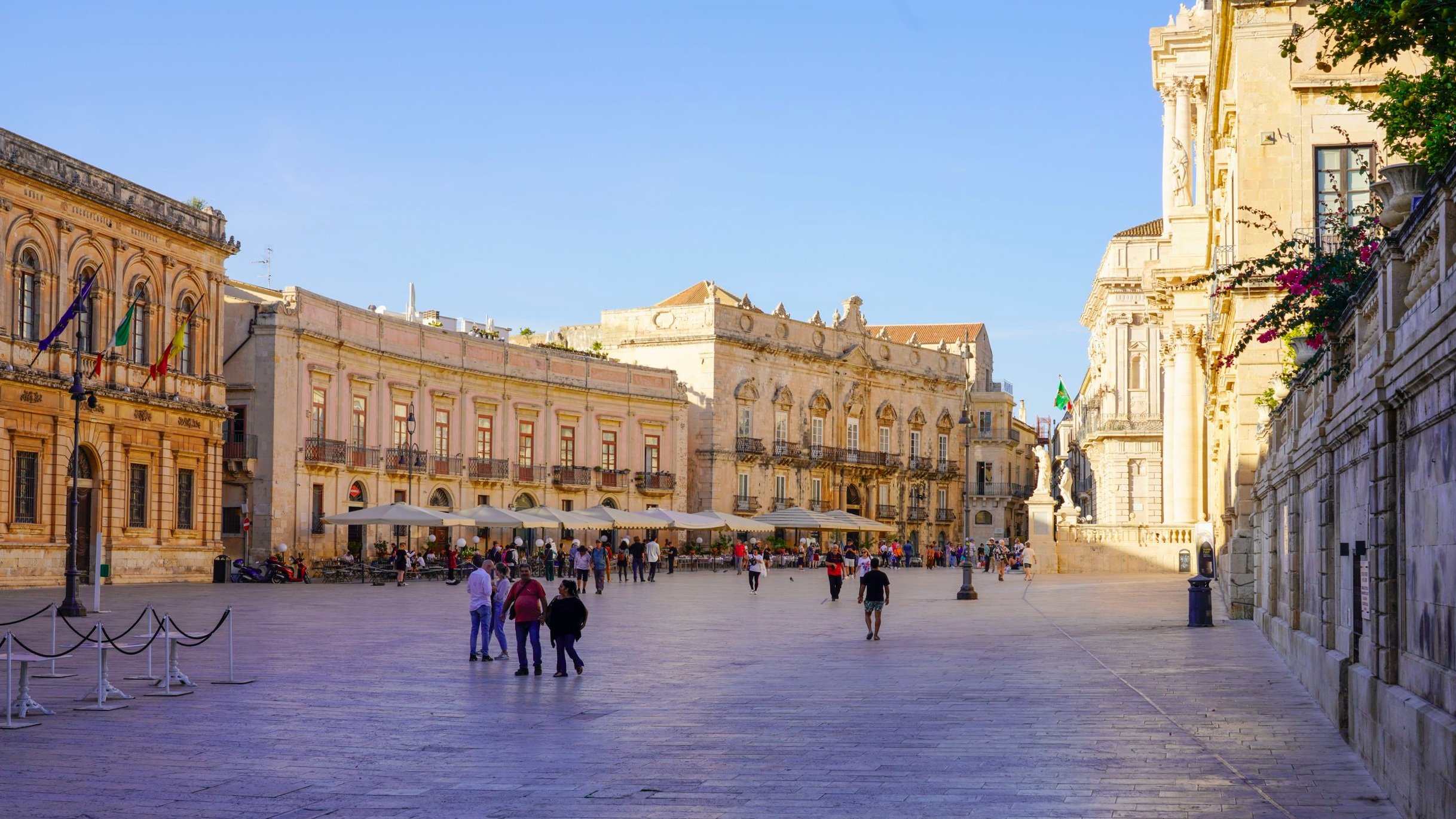
The most important building in the square is, without doubt, the Baroque Cathedral of Siracusa (right), dedicated to the Nativity of the Blessed Virgin Mary. The Cathedral, located to the east of the square, incorporates parts of a Greek doric temple dedicated to Athena, the ancient Greek goddess of wisdom and war. The Palace of the Superintendence of Cultural Heritage of Siracusa, followed to the north by the Palazzo Arezzo della Targia and the Palazzo Beneventano del Bosco, are on the west (left) across from the Duomo.
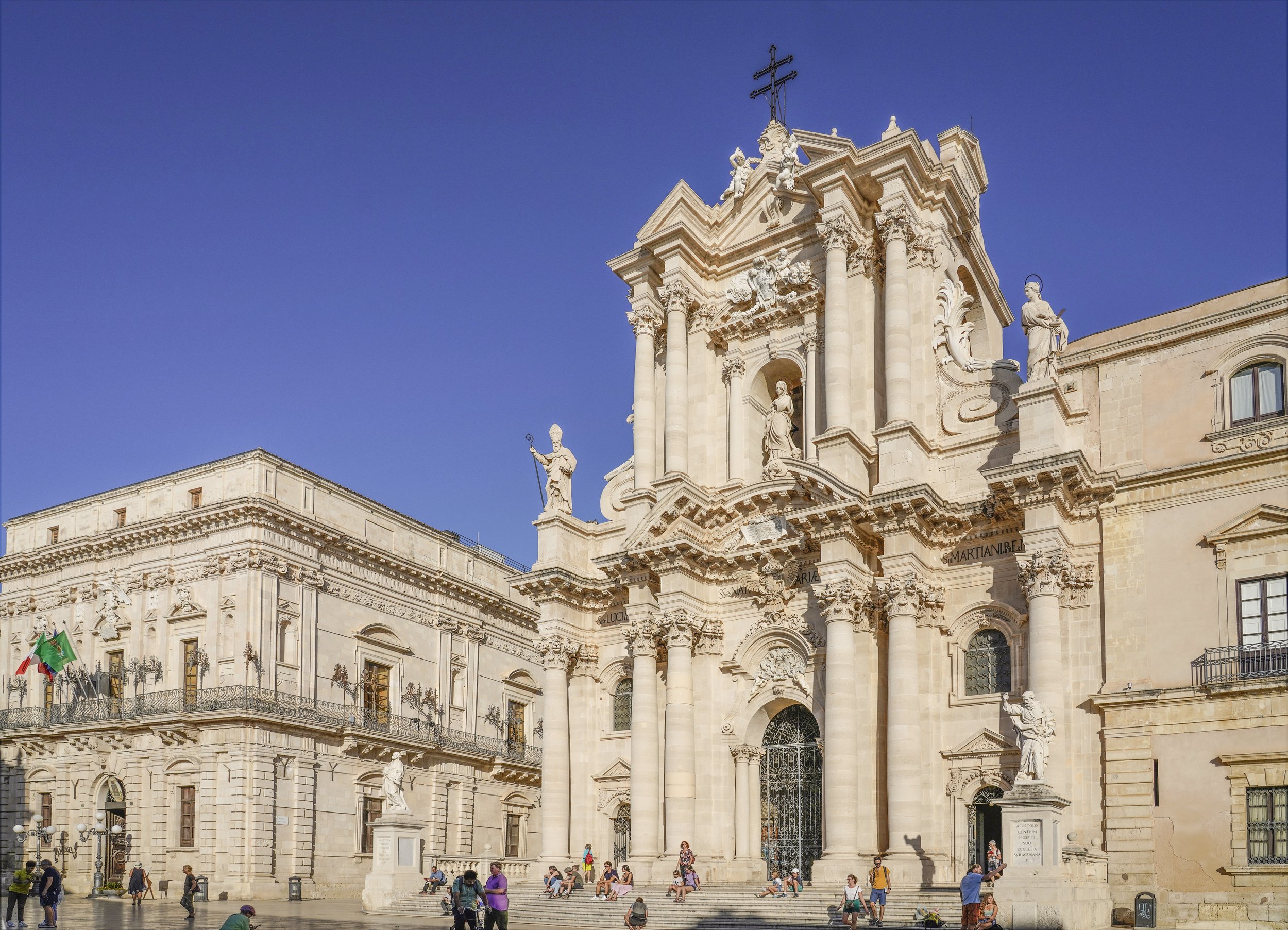
Siracusa Cathedral began life as the Greek Temple of Athena. In 535 CE, the Byzantines converted the temple into a church; it was dedicated to the Nativity of Mary. The Arabs conquered Sicily in the 9th century and converted the church into a mosque. In the 11th century, Siracusaa surrendered to the Norman King Roger I. He renovated and transformed the building back into a working church. In 1693, an earthquake destroyed the Norman facade and it was rebuilt by the architect Andrea Palma, a major works in Sicily during the 1700s.

The facade, on the first level, contains statues of St. Peter and St. Paul. St. Peter (above) holds a keys in his left hand and a book in his right hand. The keys represent Peter’s authority as the leader of the twelve apostles and the head of the early Church. Jesus said to Peter, “I will give you the keys to the kingdom of heaven.” The book is attributed to Peter as he is the source for Mark’s gospel and he preached God’s word. The Latin inscription states, The Apostles, principal founders of the Syracuse Church.
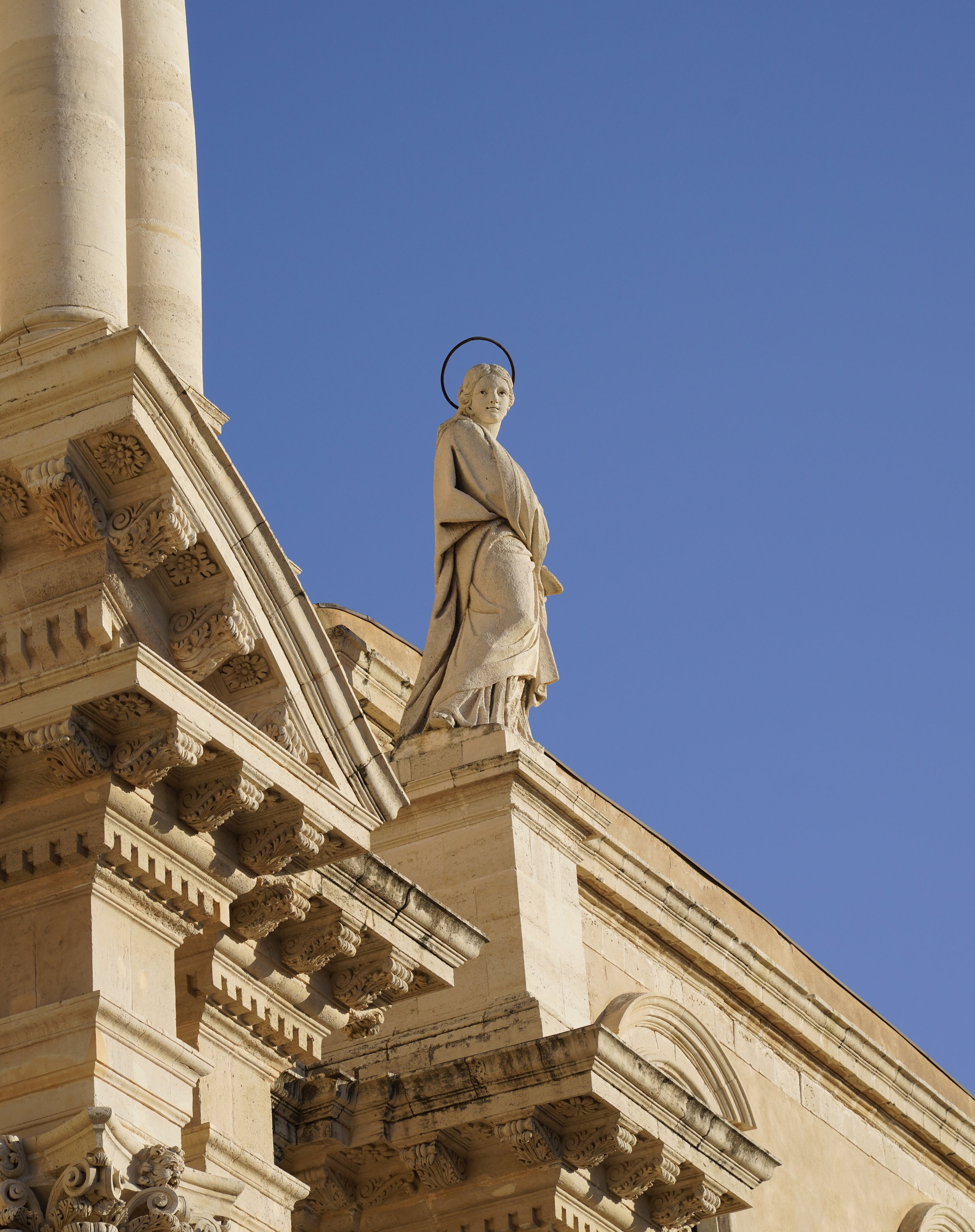

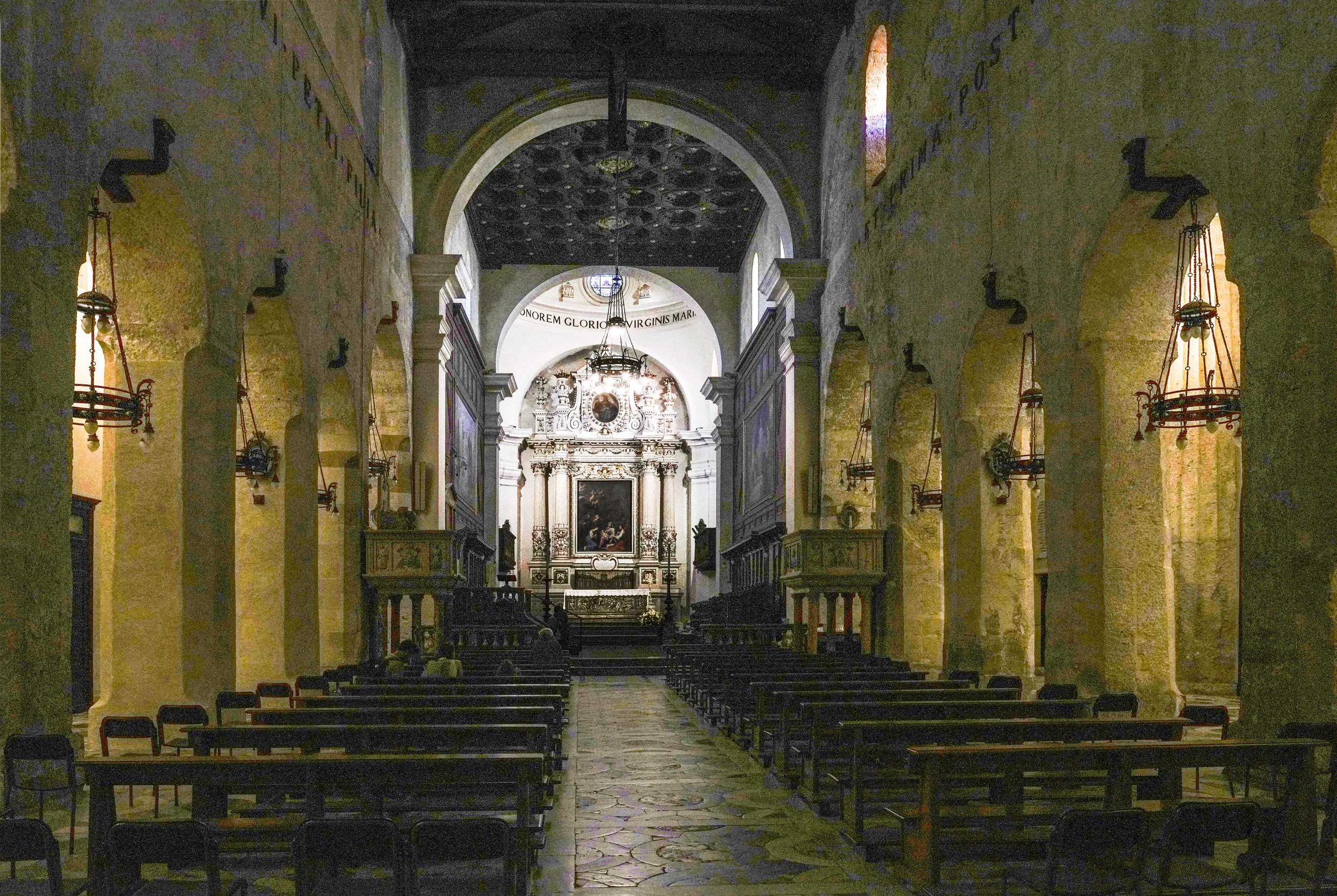
The interior of the Duomo contains one of the most important Doric monuments in all Sicily: the Temple of Athena. The Greek Temple was built in 480 BCE by the tyrant Gelone after the victory against Carthage in the battle of Himera. The Temple columns are clearly visible as well as some parts of the interior chamber. The Byzantines in the 6th century converted the temple into a church: included the exterior colonnade in the outer walls of the church and opened eight arches on each side of the interior chamber to create a building with three naves, dedicated to Virgin Mary.

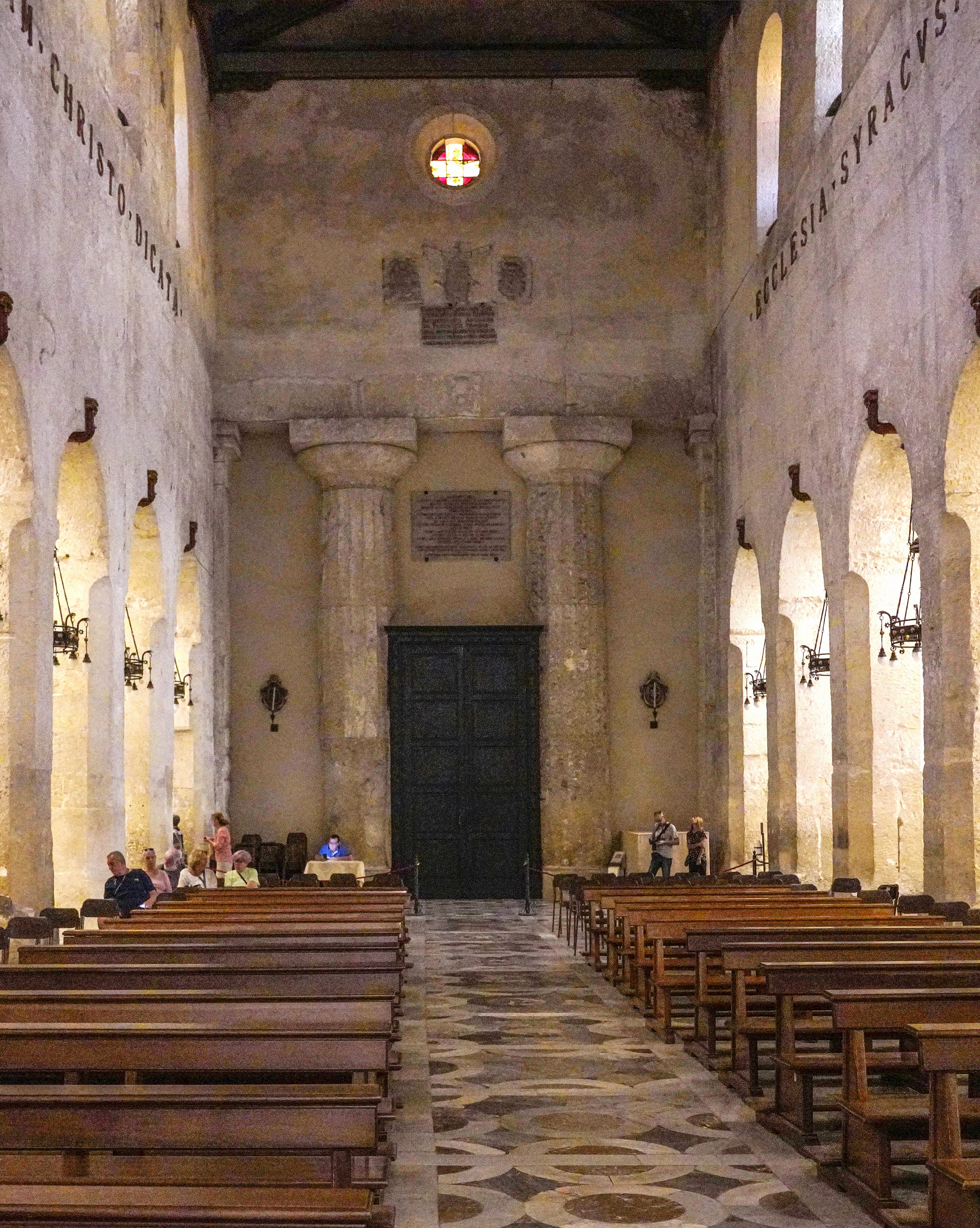
Flanking the south entrance door there are two gigantic columns from the opisthodomos, i.e., the rear porch of the original Greek temple of Athena that was on the site. The opisthodomos came to be a treasury, where the revenues and precious dedications of the temple were kept. Above the arches on both sides of the nave a Latin inscription indicates that the Duomo is the oldest Christian church in Europe: "Ecclesia syracusana prima divi Petri filia, et prima post Antiochenam Cristo dicata," which translates to The Siracusa Church was the first daughter of St. Peter, and the first after Antioch dedicated to Christ.

In the 15th century the Normans remade the Duomo floor in this polychrome marble. The circle is a universal symbol in many cultures and faiths of God, Infinity, Unity and Wholeness.
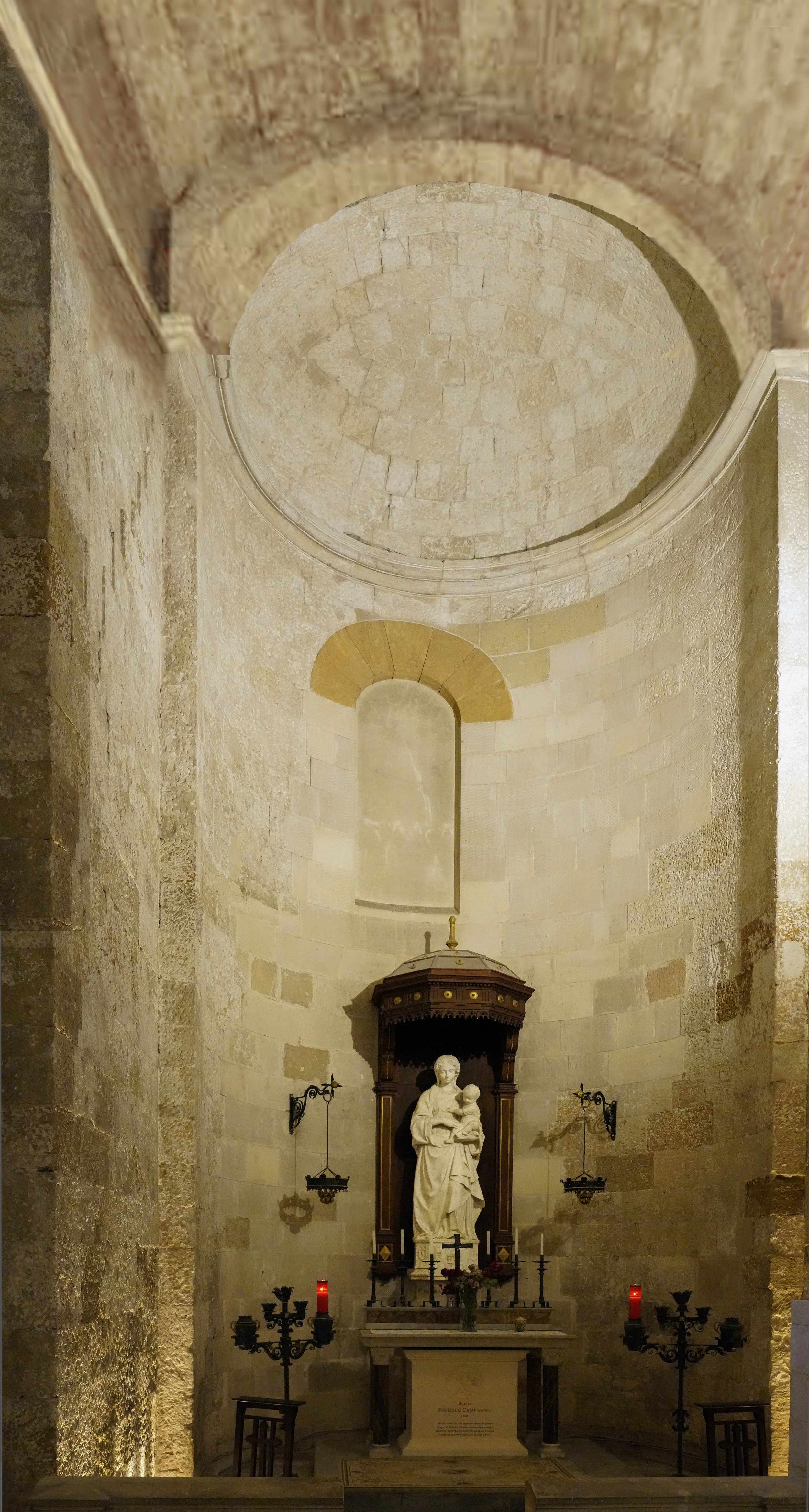

On the night of August 4-5 in the year 358, it is purported that a miracle took place in answer to a prayer. A Roman patrician by the name of John and his wife had been praying to the Blessed Virgin, asking her what to do with their wealth. Childless, they desired to give their entire fortune to Our Lady but needed to know what the Blessed Mother would have them do with it. That night in a dream, the Blessed Virgin appeared to them and told that she wanted a church to be built on the Esquiline hill in Rome, and that she would show them where the church was to be built by covering the area with snow. Our Lady also appeared that night in a dream to Pope Liberius, telling him of her desire that a church be built and instructing him to go to the same hill. The next day both arrived at the hill to find an exact area covered with snow, an extraordinary miracle in the hot, muggy Roman month of August. The area the snow covered was marked off and Pope Liberius ordered that construction begin immediately on a new church. This church was to become known as St. Mary Major, which soon became the most important church dedicated to the Blessed Virgin in the West. (https://www.motherofallpeoples.com/)

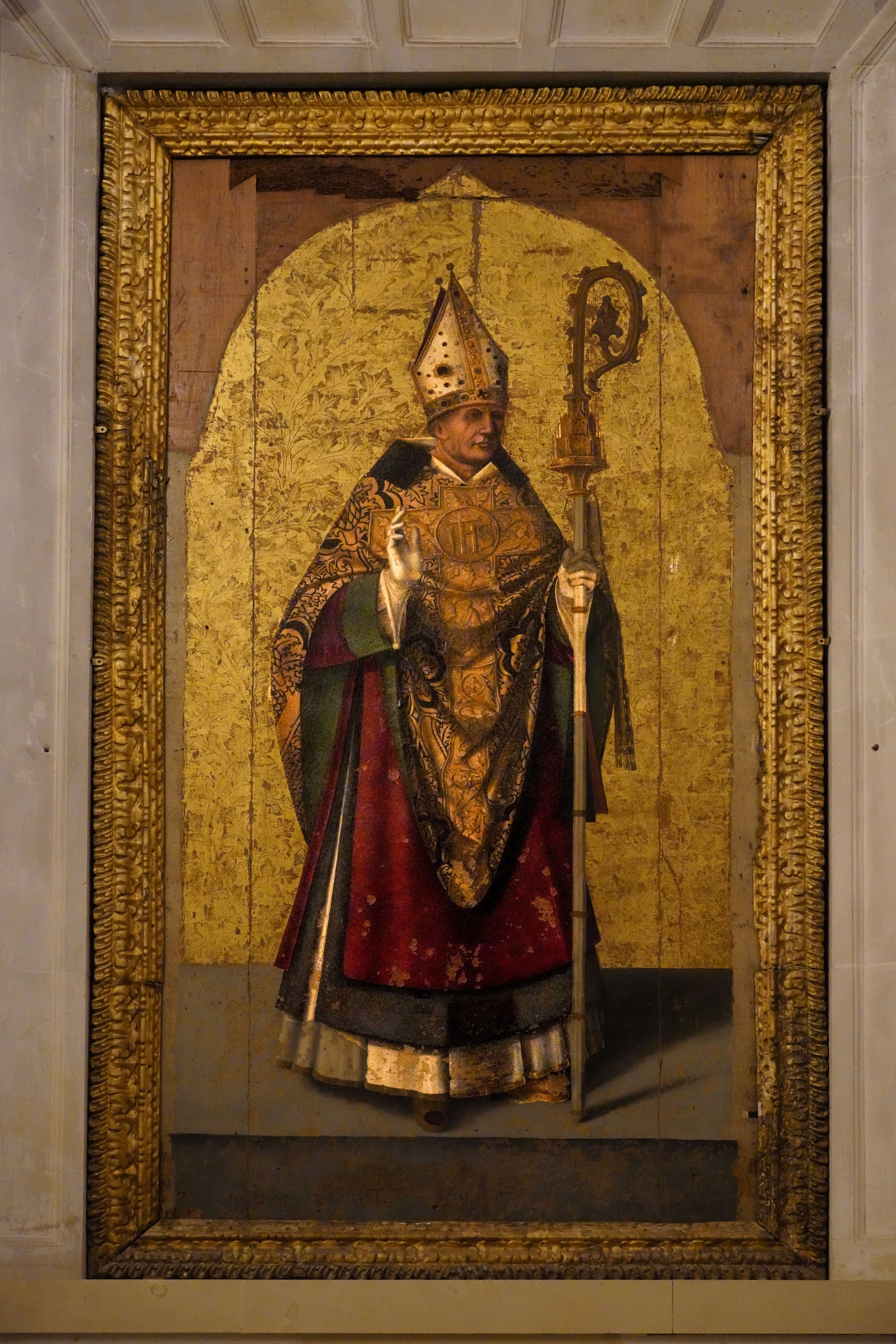
Marciano is considered the first evangelizer of Christianity in Siracusa, where he arrived in the year 39 CE, sent by Saint Peter, of whom he was a disciple. He is considered the first Bishop of Siracusa. His preaching was completed with that of Saint Paul. He made many conversions, for which he suffered persecution by the local Jewish community and in the year 68 CE he was martyred.

Santa Lucia was martyred during the Diocletian Persecution, the last and most severe persecution of Christians in the Roman Empire. In 303 CE, the emperors Diocletian, Maximian, Galerius, and Constantius issued a series of edicts rescinding Christians' legal rights and demanding that they comply with traditional religious practices, while later edicts ordered all inhabitants to sacrifice to the gods. Local judges often enforced executions during the persecution, as capital punishment was among their discretionary powers.


The left side of this photo illustrates how the doric pillars of the original 5th century Temple of Athena were incorporated by the 6th century Byzantines into the walls of the cathedral. They are also visible from both the interior of the cathedral.
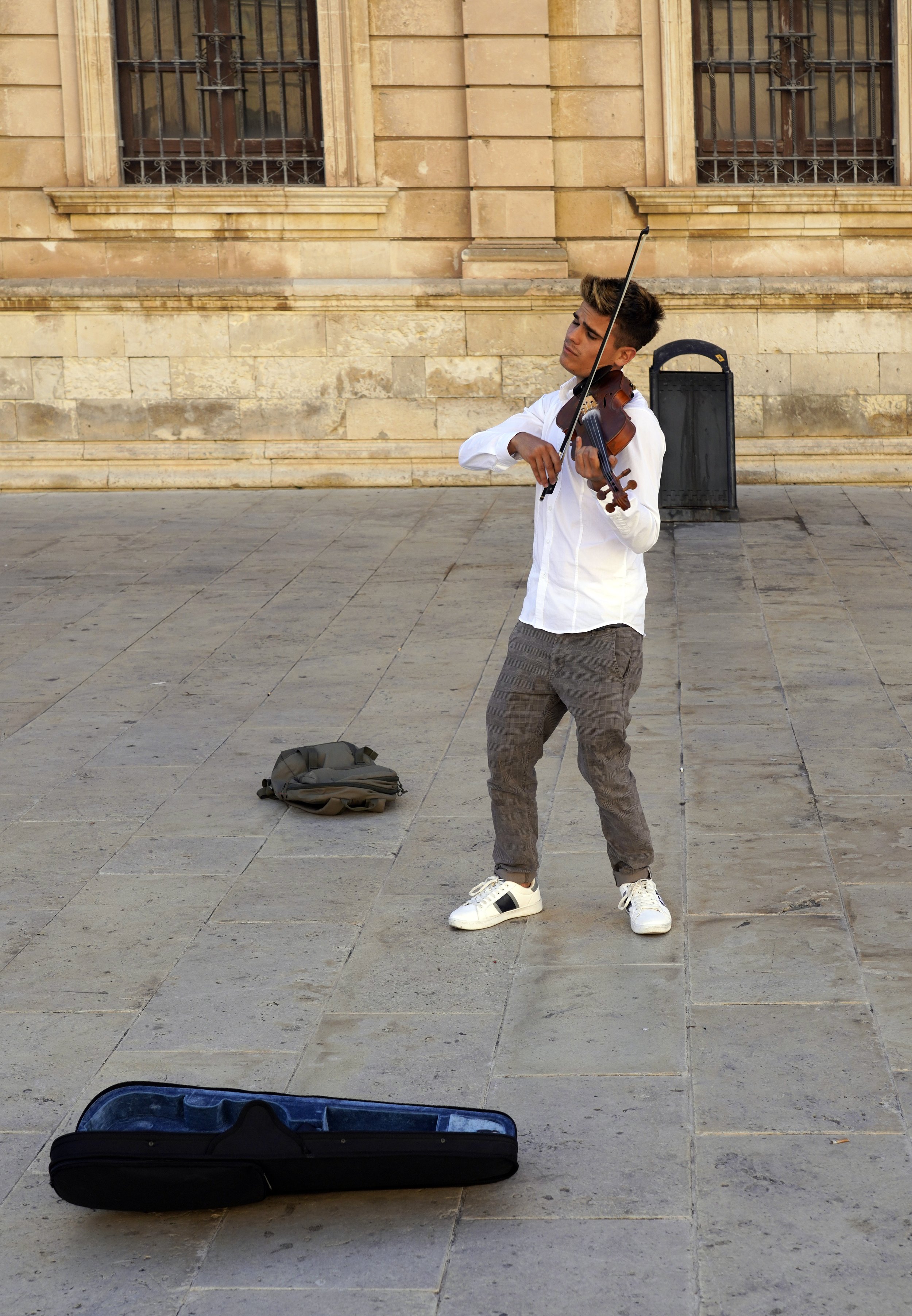
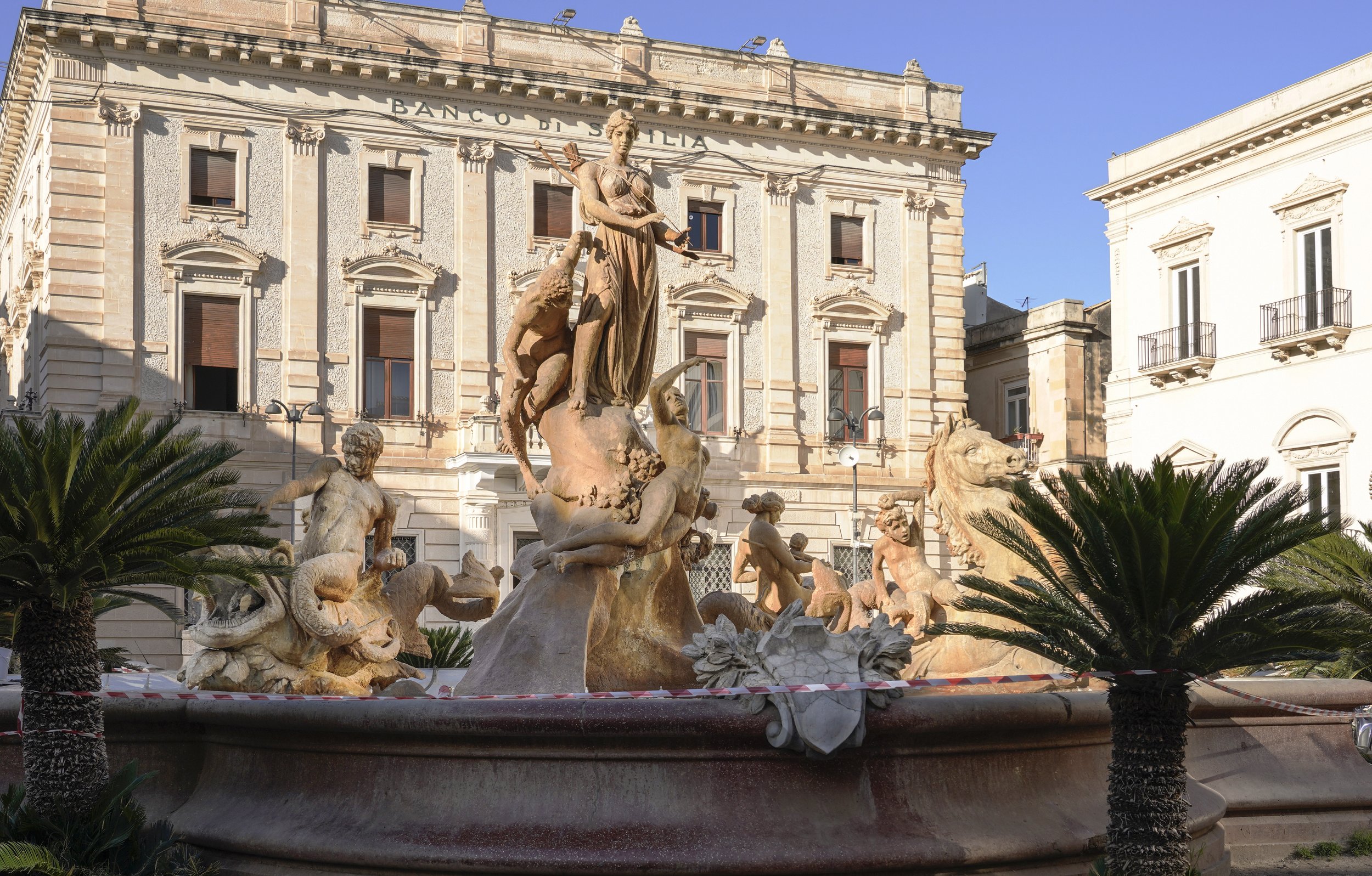
Diana/Artemis is the goddess of the hunt, wild animals and wilderness, childbirth and virginity, and was often shown carrying a bow and arrow. The fountain includes a triton and a mermaid with a child on her lap riding sea monsters. The fountain pays homage to the most famous myth of the city of Syracuse, that of the Fonte Aretusa. The legend tells that river god Alpheus fell in love with Aretusa, nymph of the goddess Diana/Artemis, and he tried to seduce her in every way. Aretusa invoked the intervention of the goddess that turned her into a spring, whose natural water is ideally combined (albeit with an artificial source) to this fountain.
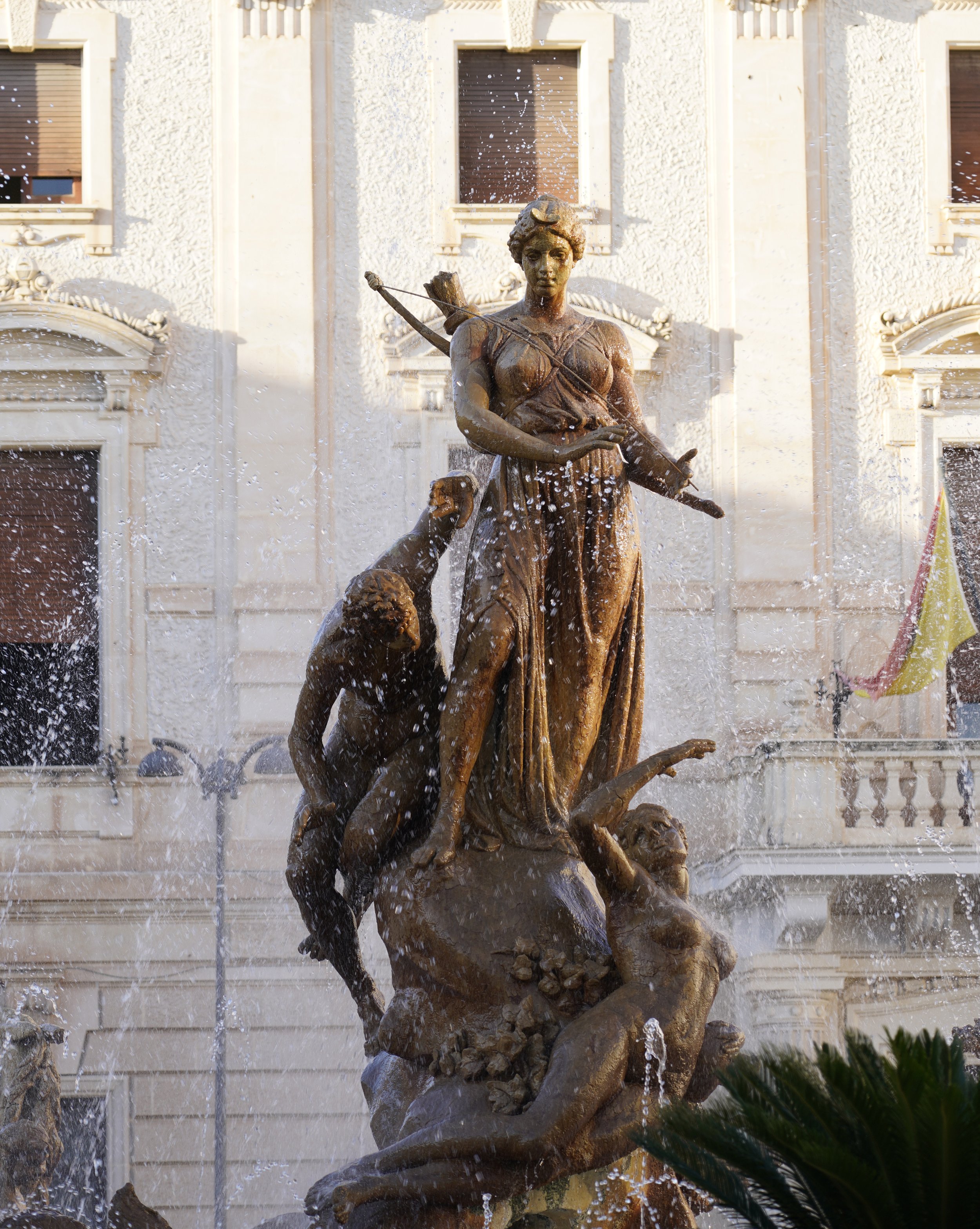
In the center of the fountain, in a dominant position, on a high cliff-shaped base stands Diana / Artemis with a bow, quiver and a dog; At his feet is represented the nymph Arethusa at the exact moment in which the goddess Diana /Artemis is about to transform her into a spring to be able to withdraw her from the insistent loving attentions of Alfeus, who fell in love with her after seeing her bathing nude in a stream.